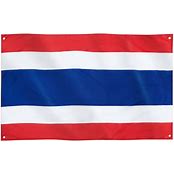
I have often wondered what Thailand, called Siam until 1939, is like. I had heard tales of its splendid golden temples, white sand beaches and vibrant street markets. Some ex colleagues of mine have even bought apartments here. Once I went to a theatre production of the musical ‘The King and I’, set in Siam ‒ so romantic and colourful and evocative. A beguiling destination then, full of eastern promise.
Thailand has been ruled by the kings of the Chakri dynasty, founded by Rama I, since 1782, the current King being Rama X. Around 95% of the population are Buddhist, which accounts for the 300,000 or so temples or ‘wats’ in the country. Many of these magnificent edifices have been built and/or restored during the reign of this dynasty.
The country was never colonised by European powers, unlike the rest of S.E. Asia. It was King Mongut (titled Rama IV, portrayed by Yul Brynner in ‘The King and I’ film) who managed to retain Siam’s independence, although he was forced to make concessions to some of those powers, such as the British. King Rama IV (ruled 1851-1868) opened up Siam to western influences, endeavouring to modernise the country. He encouraged other members of the Royal family to have a European education and he spoke English well. He did actually employ an English governess to teach his children. The pair fell in love (in the film). During WWII Thailand was invaded by Japan and formed an alliance with the Japanese (see Thailand: The Bridge over the River Kwai). More recently it has become a prime tourist destination.
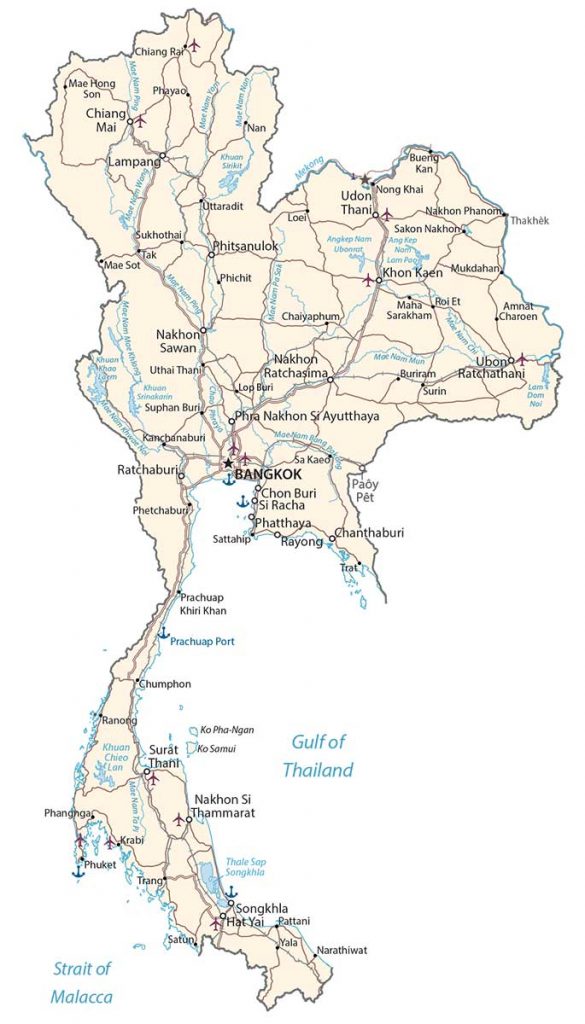
So here I am in Bangkok, having taken the flight from Singapore’s fantastic airport with its carpets throughout, soft chairs to bask in, and artworks. Bangkok’s airport is nothing to write home about in comparison but, equally, there are no issues.
Bangkok
I have navigated myself out of the airport onto a train, alighted but now can’t find my way out of the station. End up staggering with my suitcase down some stairs to emerge into Bangkok’s celebrated traffic onto a main road rather than to an internal taxi rank. How did I manage that I wonder. Anyway, a taxi stops and the driver requests far too many bhat for his services. He refuses to turn his metre on. So I say no thanks. Getting savvy. Another stops right behind and this driver switches her metre on. I get in. “Why you not take that taxi”? she asks. I enlighten her. After 15 minutes or so in the hideous traffic – reminds me of Chennai (see India, part 1) – we pull up at a nondescript high-rise, which appears to be the hotel I have booked. Room is on the 17th floor overlooking more high-rise blocks and a highway. Anyway, I arrange for some milk to be delivered to my room. It arrives in a small jug, which means that, together with my usual teabag supply, I can conjure up a brew. Soon feeling upbeat.
Don’t have a guide book for Thailand so use Google maps to find the river. It is west of the hotel. Doorman also points out the direction. Emerge into the heat. Bit unsure. Meet two men in shorts walking towards me. “Do you speak English by any chance?” “Yes”. I put the question to them. “Oh, we can’t find the river. We turned right at the junction. Maybe if you turn left…” I duly turn left, which is west as the sun is lowish ahead of me, and it is about 1700 hours. Good. Walk along the road and cross a zebra crossing. Bit hair-raising. Does that car intend to stop for me, I ask myself.
Bangkok is grubbily colourful. Little stalls all along the road are selling foodstuffs, flowers and trinkets. Occasionally a shop pops up between said stalls with VISA signs on windows, displaying huge amethysts or statuettes of gods. On the pavement a lady without a lower leg is begging. This is not Singapore.
Chao Phraya River
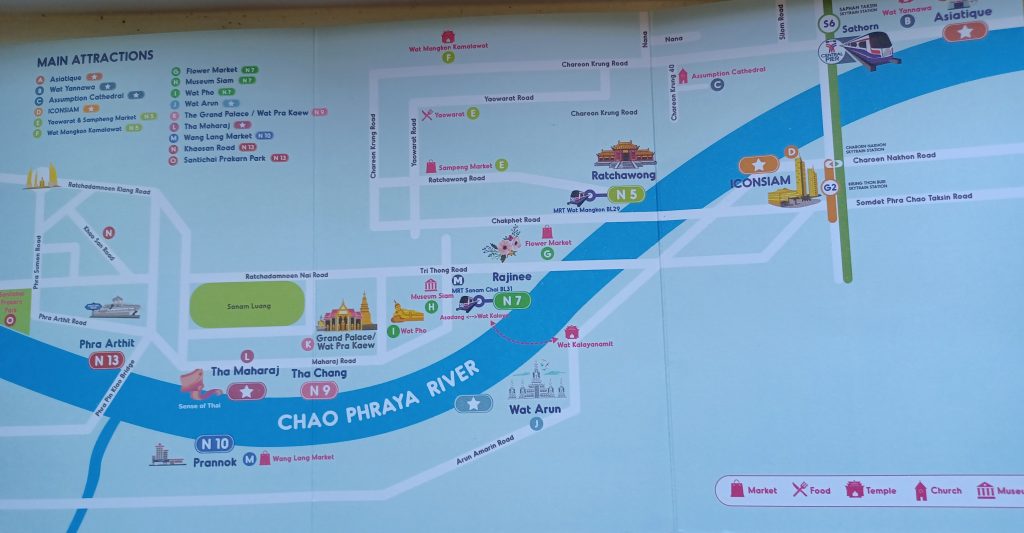
Eventually I see a sign on the right saying ‘Central Pier’. That implies a river. Rejoice. Bit chaotic on the pier, also known as Sathorn Pier, but cheery ladies are selling tickets for the tourist boat. Buy a ticket and ascertain that it will take me to the last stop, then I have to get off and buy another ticket back. Hop-on, hop-off service. OK. The river is called the Chao Phraya, the longest river in Thailand, which flows through Bangkok, having started its journey way up north at the junction of the Ping and Nan rivers arising in north Thailand and Laos respectively.
As it is nearing sunset and thus not too horribly hot, I ascend to the top deck. Nice breeze and the sun is behind me. Deck is full of tourists, many speaking Mandarin very loudly and spouting telephones in every direction.
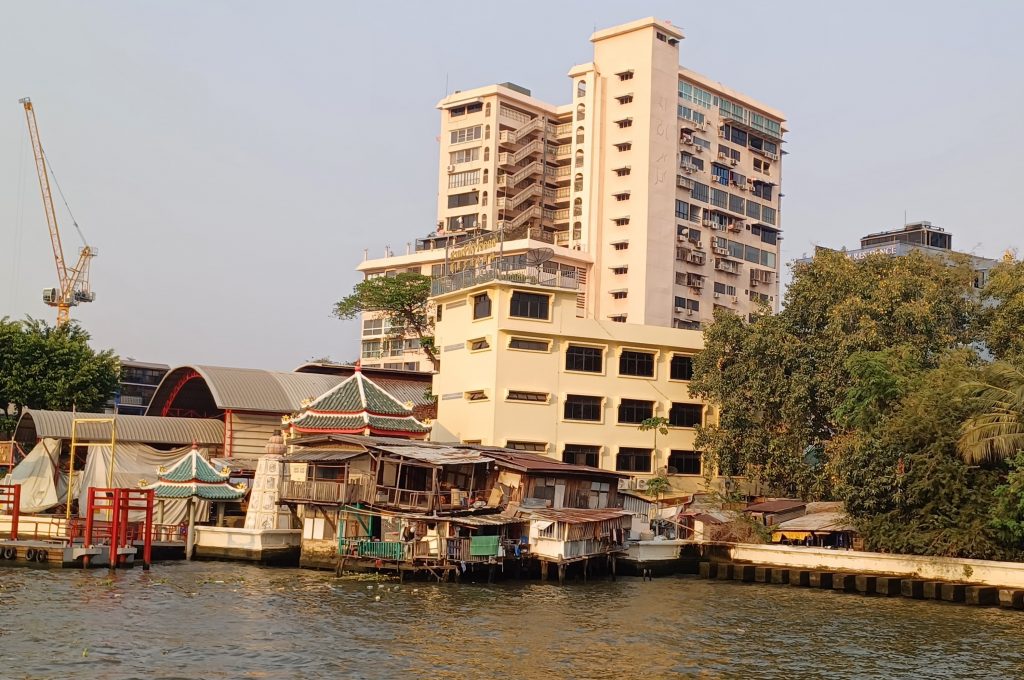
We pass ramshackle houses on stilts, which look like they are crumbling in to the water, standing alongside smartish modern buildings and temples with tiled rooves. Egrets float along the river upon drifting lilies and the odd plastic bottle.
The boat stops at several piers, zig zagging across the river to the right bank, then the left bank. At each pier, some alight, others board and dash up the steps for those prime upper deck seats. A female voice announces the names of the stops in Thai, Mandarin and English. A party boat with loud music blaring out passes us. Its occupants are dancing. Several long stripy boats with long extended tillers and large engines zip along the river. Sporting stripy awnings and strings of flowers draping from their bows. I spot two already moored up for the night. And other boats of various shapes and sizes ply the waters.
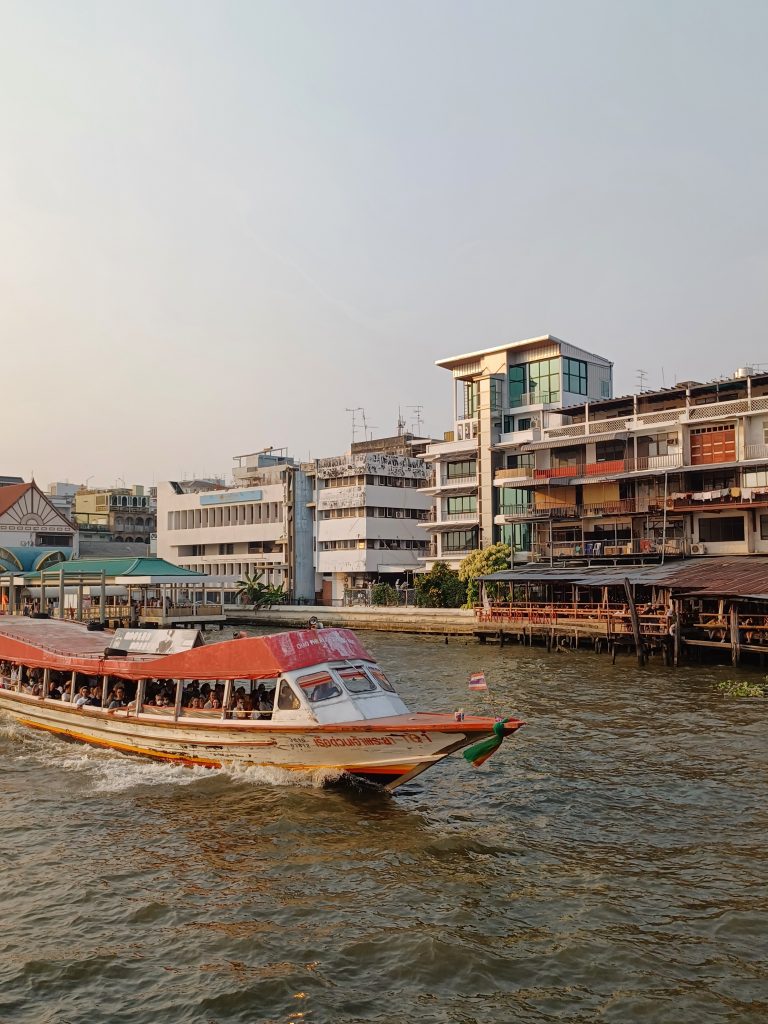
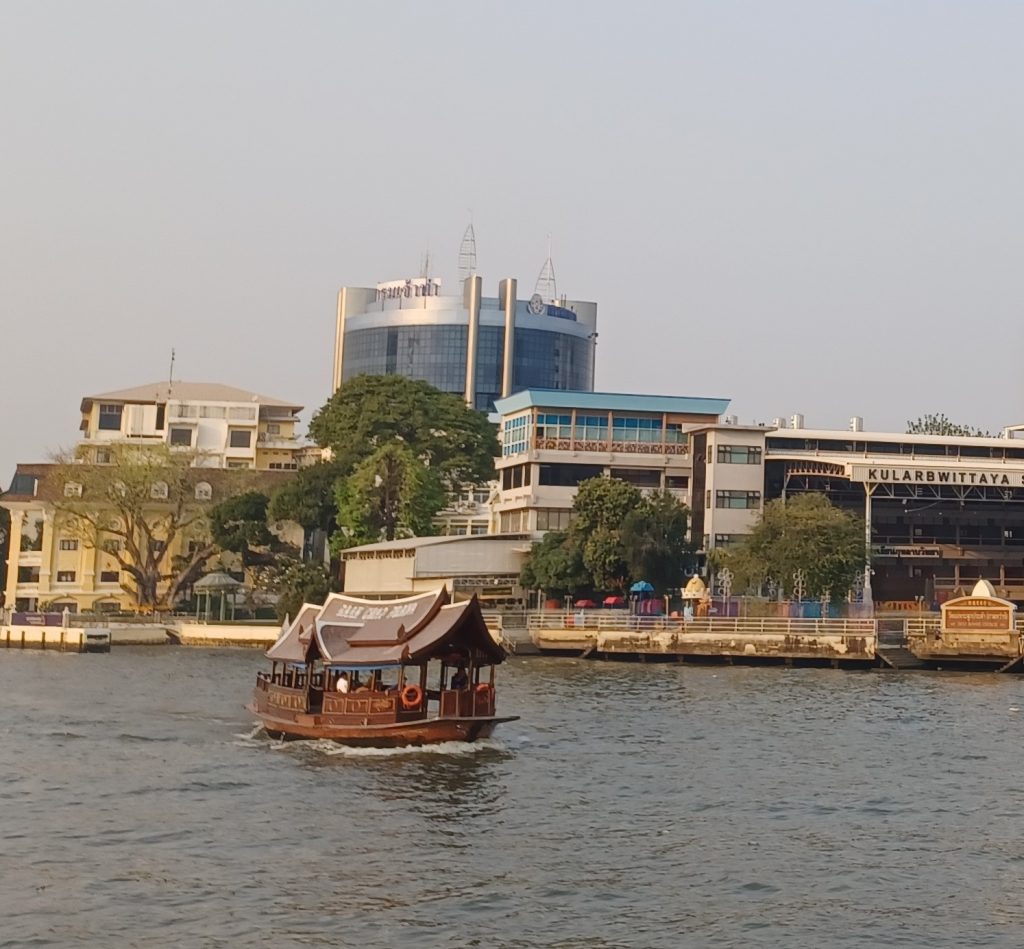
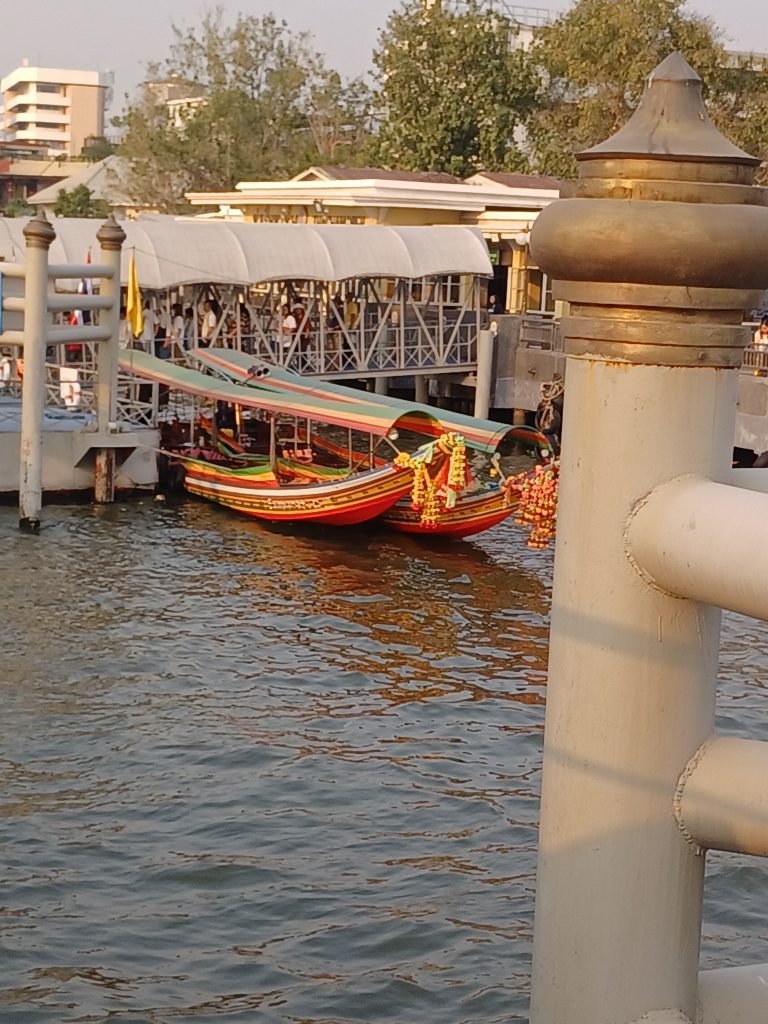
A tree appears full of perching egrets amidst temples with golden prangs. The Grand Palace, I believe. Some police boats are hovering in front of the pontoons. We pass a pagoda – Chinese style – with a huge high rise to the left of it. And on the other side of the river near the Central Pier a church painted cream.
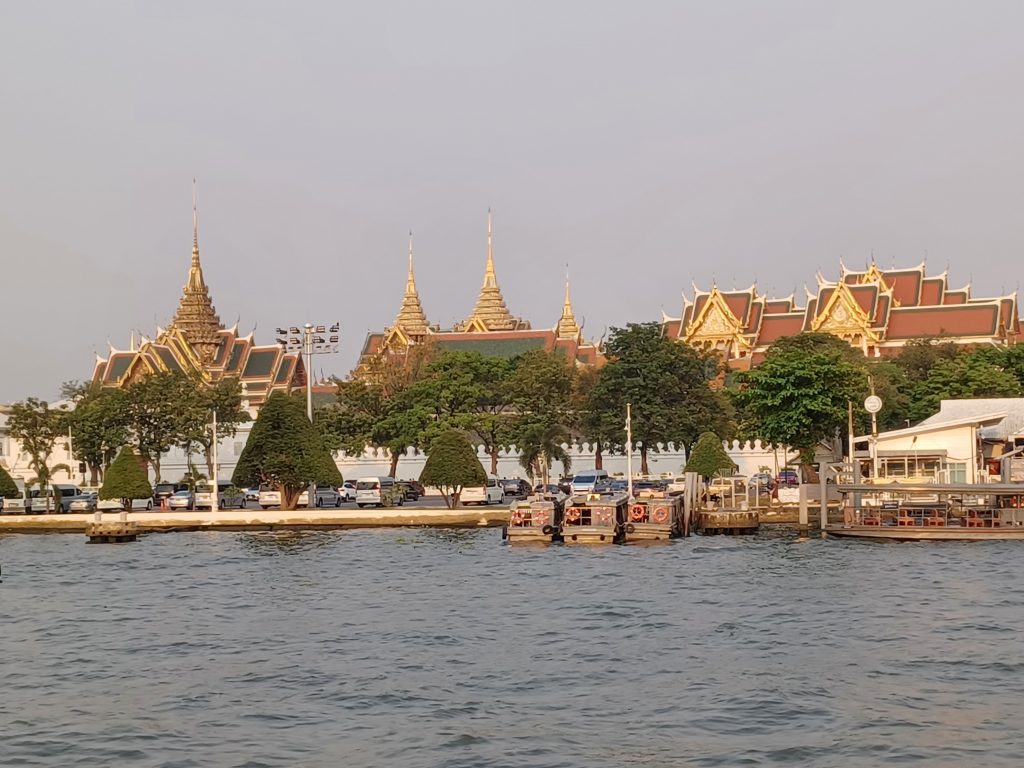
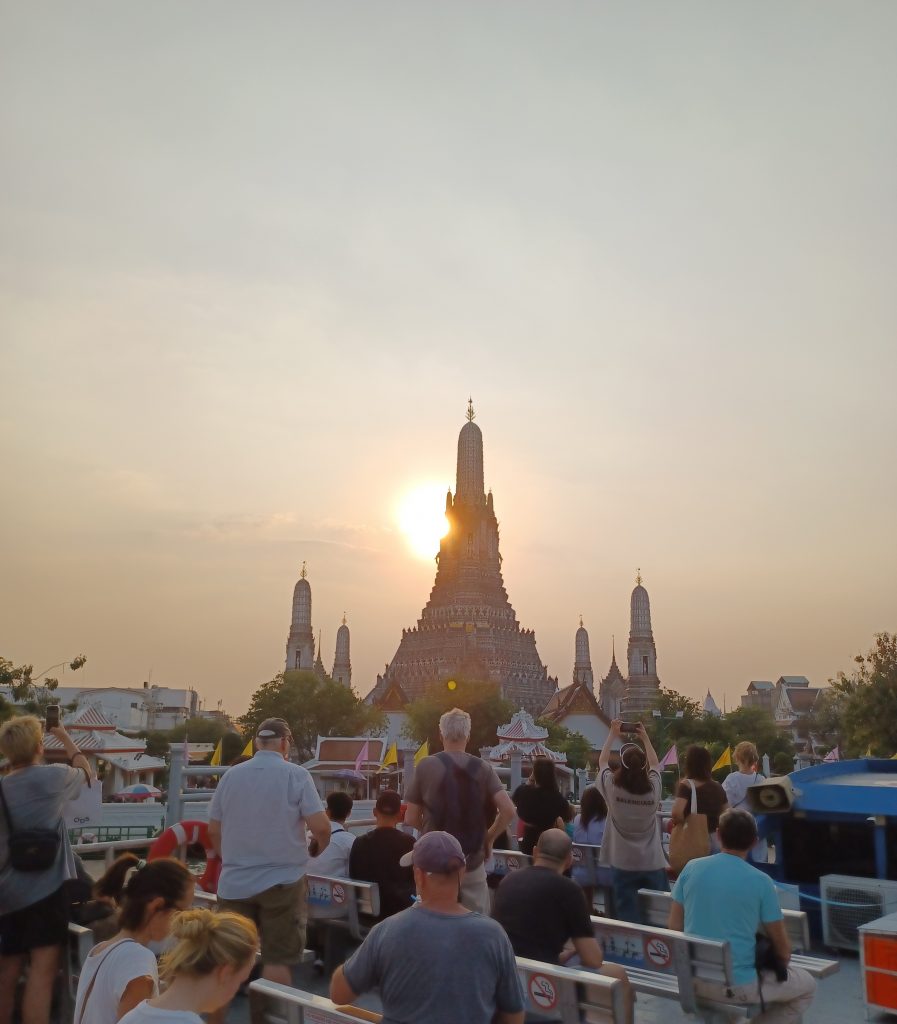
The distinct Wat Arun central spire or ‘prang,’ poses grandly with the sun passing behind it. A somewhat impressive landmark. Four smaller prangs are placed around it. People hasten to snap pictures. The Royal Thai Navy HQ is located next door to the Wat incorporating a structure that looks like a lighthouse with the Thai flag flying above it. The red of the Thai flag represents blood from all the wars, white the purity of the Buddha and the blue for the Royal Family, I understand.
Back to the Central Pier and my hotel. Good recce. I plan to explore further on the morrow.
Wat Arun
The high pitched high volume sing song voice of the Thai ticket lady directs the herd of tourists onto the Chao Praya Tourist Boat. My plan is to proceed to Wat Arun, behind which I saw the setting sun yesterday. This time I sit on the lower deck in the air-conditioned seating. It is hot up top. Soon the distinctive prang of Wat Arun appears. The four smaller prangs stand at the cardinal points. These represent the four winds. Boat grinds to a halt as another female Thai boat lady tells us in an equally loud voice to alight at the back. “Quick, quick!” as more tourists get off exchanged with a load more getting on. OK, OK.
The name, Wat Arun, derives from Aruna, the Hindu God of dawn. Situated on the west bank of the river, the wat has been on this spot for 300 years, having been built during the Ayutthaya Kingdom in the seventeenth century. The structure represents Mount Meru, the centre of the world in Buddhist cosmology. King Rama II restored the temple in the early nineteenth century and his ashes are enshrined here. During his reign (1809-1824), Siam was a peaceful country, according to a notice, and there were no wars. He strengthened the kingdom and traded with many foreign powers.
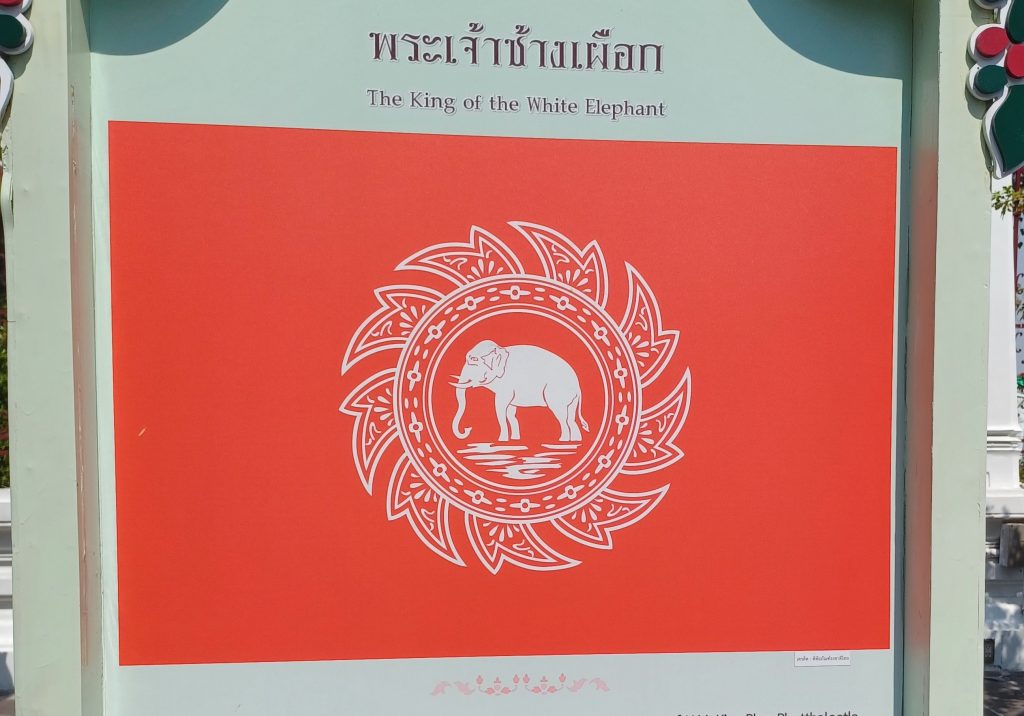
He was known as the King of the White Elephant as he owned three white elephants. He was also the royal patron of Buddhism. Thus, the flag of the Royal Trading Ship was a white elephant inside a Chakra wheel, an important Buddhist symbol, with a red background.
King Rama III, taking up the aspirations of his father, built the large central prang. It took nine years to build, completed in 1851 at a height of 81 metres with a seven pronged trident on top, the trident of Shiva. Buddha’s relics were placed in the prang. The King passed away soon after completion. And the ensuing King Rama IV gave the temple the full name Wat Arun Ratchawararam, denoting the highest status Royal Temple. Said King Rama IV was a monk for 27 years before becoming King. All young men in Thailand of 20 years old can be ordained as monks for a time, I understand, and are highly respected.
The wat is intricately decorated with porcelain and seashells and adorned with various figures. Up some steps on the second level the prang is surrounded by mythical warriors covered with red, green and yellow mosaic pieces and porcelain shards. These warriors appear to hold up the prang, while round the base are figures carved out of stone brandishing weapons.
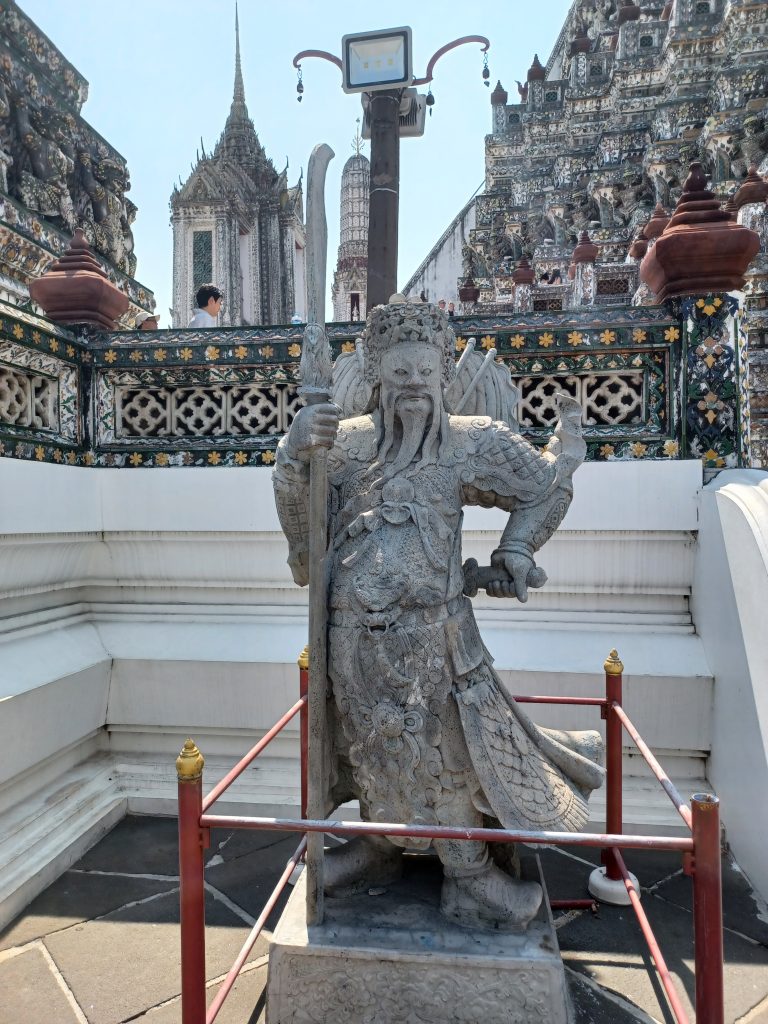
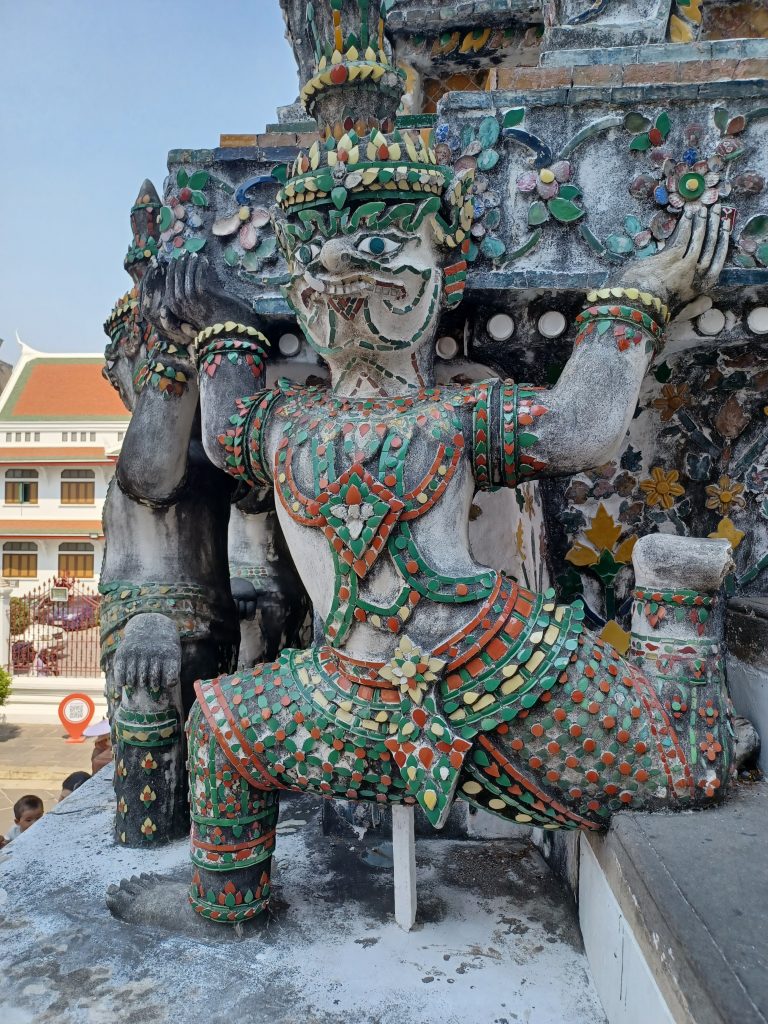
Above the 8th level of the prang, on each side there are statues of the Hindu god, Indra, upon Erevan, its divine elephant mount (see India, part 1) with three trunks in an opening. More figures surround the prang above it. I gaze up at it for a while. Mesmerizing.
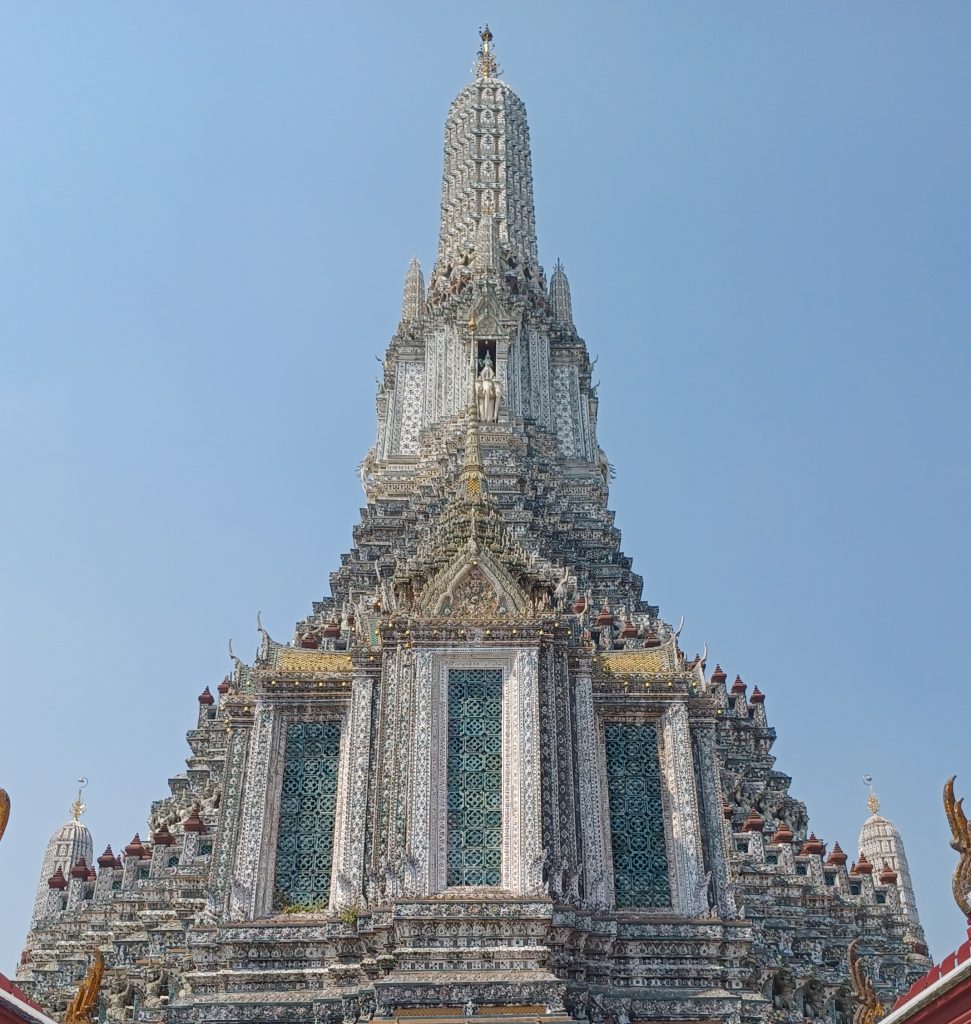
Around and about are people dressed in traditional costumes and holding parasols around Chinese style pavilions with red rooves. I enter one, the Prayer Hall, having removed shoes, to view a Buddha statue surrounded by pillars decorated with patterns. Some people are worshipping but, nonetheless, it seems that it is permitted to take photos. I do. Outside this incredible building stands a large gong. I gather this is struck by one of the monks in the morning to wake up the others.
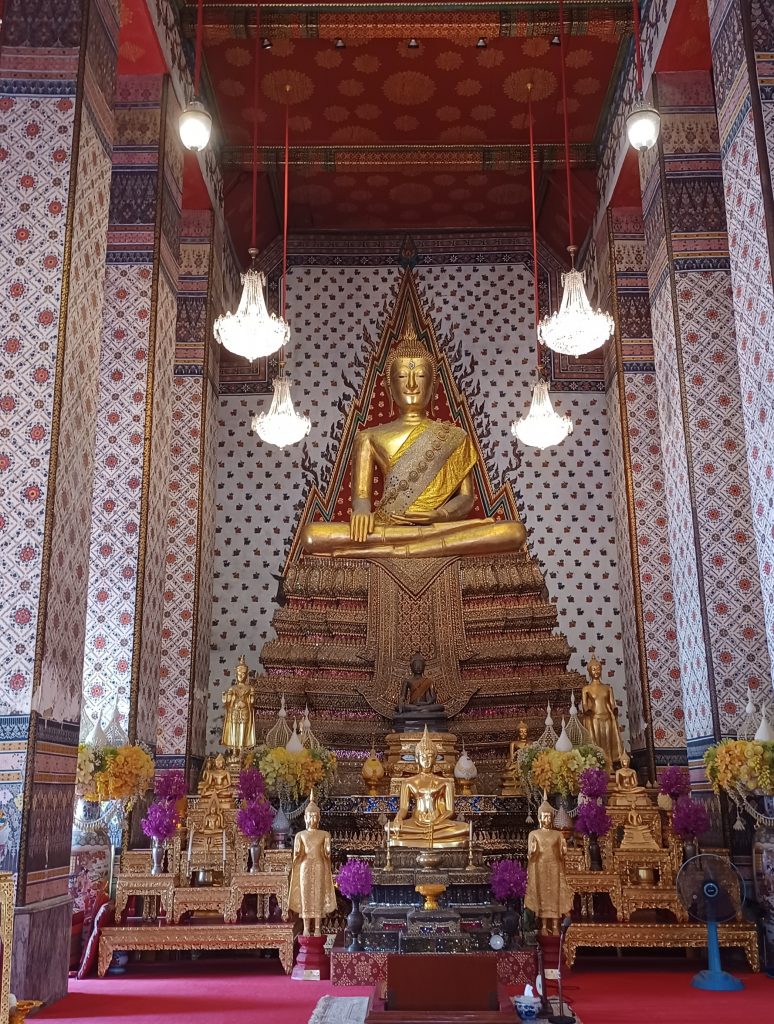
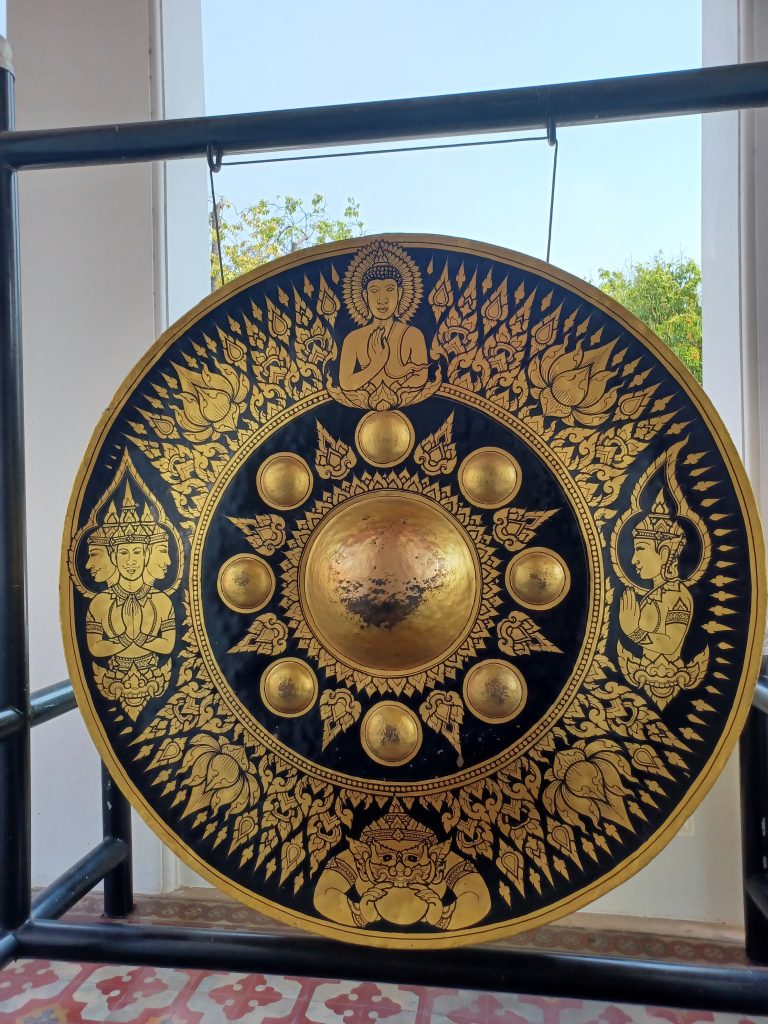
Enough stunning art and architecture for one day, I mosey back in slow time to the hotel.
Chinatown
Check out from my hotel to move to a different part of Bangkok: Chinatown. Take a taxi. Had to check out of the first one by 1100 but it is too early to check in to this one. I do a recce of the hotel surrounds. There are scores of Chinese street stalls selling anything from smelly durian to smiley snow storms, and baggy Thai trousers with elephant designs. Shops with birds’ nests (for birds nest soup), neatly packaged up in clear plastic containers, are displayed in windows, money changers’ premises and a rather magnificent wat with a golden spire. And street signs and tuk tuks and cars and trucks and more cars and taxis and buses and bikes.
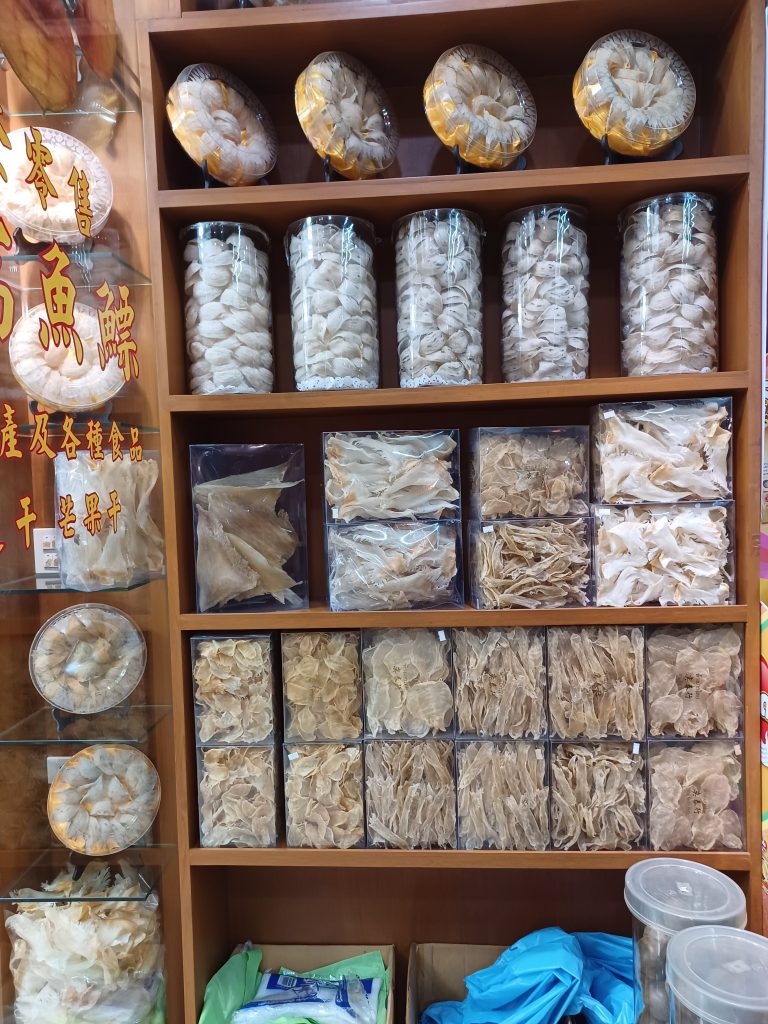
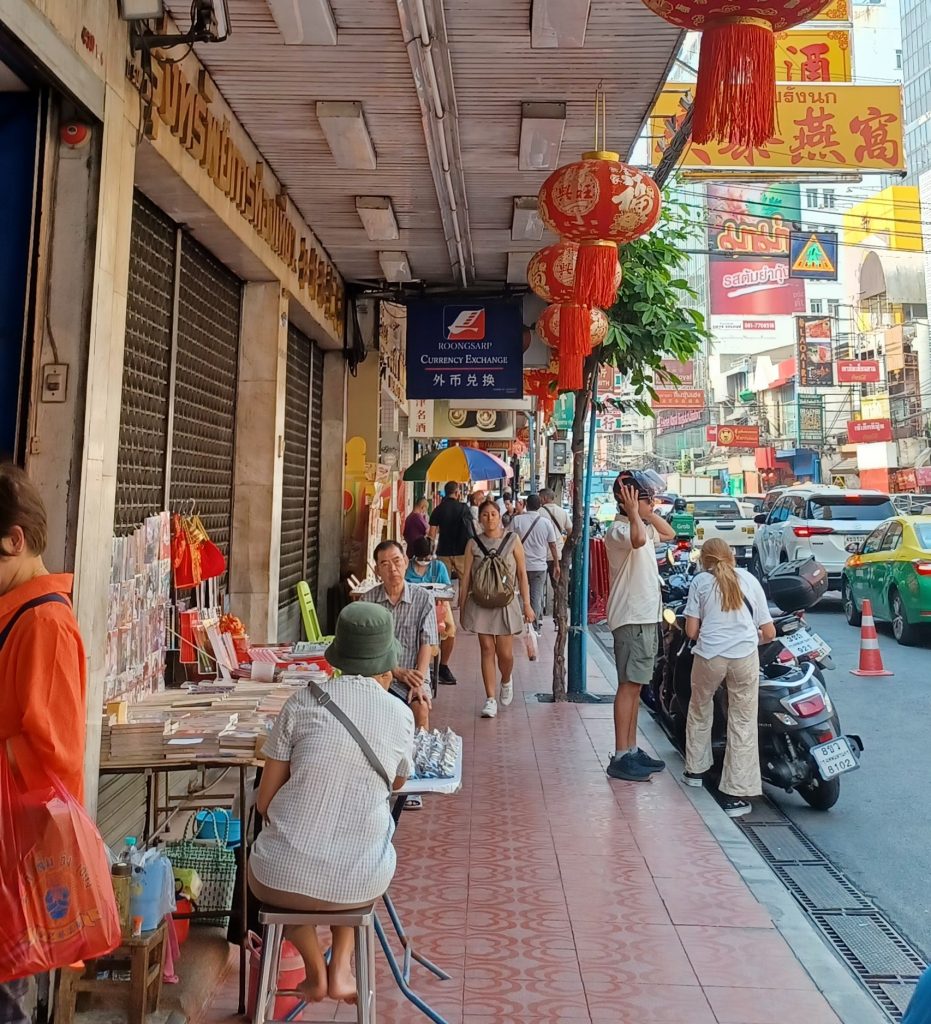
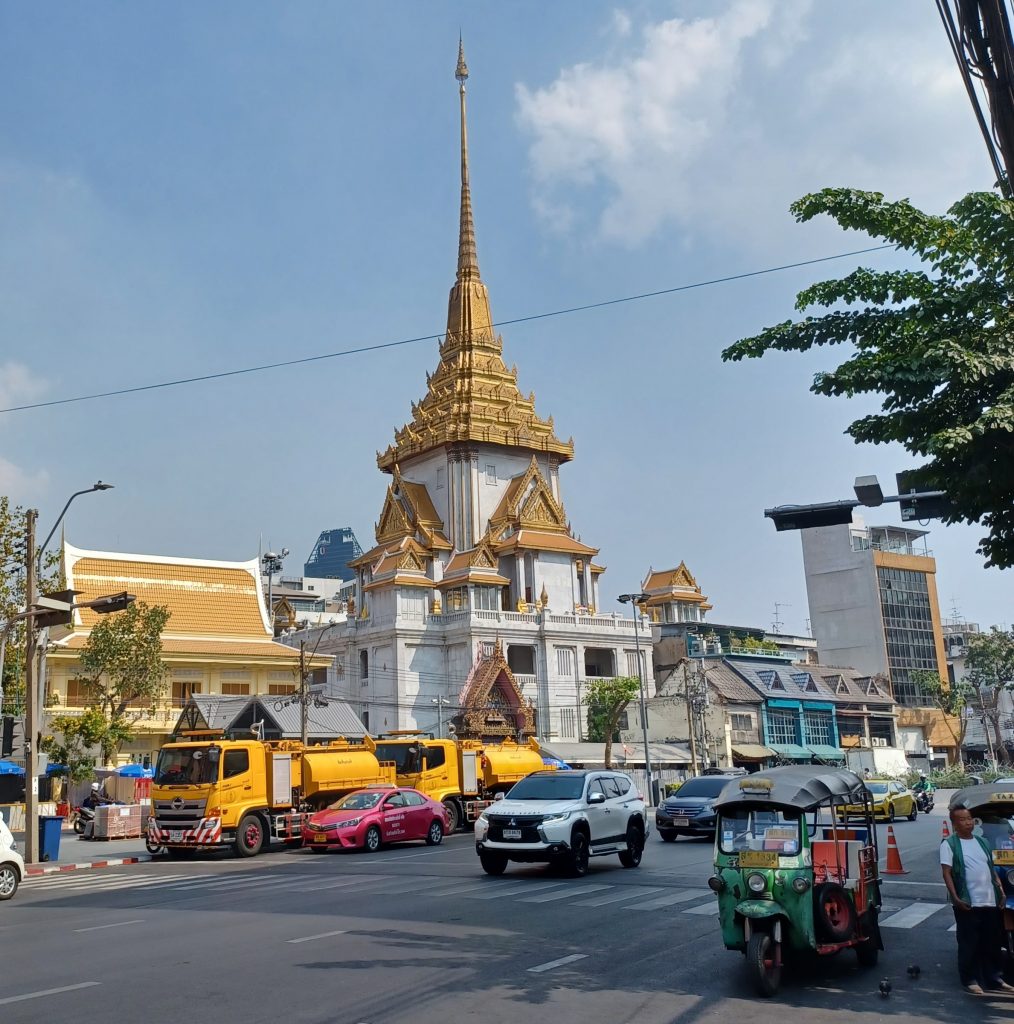
I spot a hotel with a Starbucks below it. Need coffee. Enter in. Turns out I can only pay with credit card but wish to use my bhat supply, so turn about and exit Starbucks. Find a little café in a downstairs open area with shiny tiled floor and manage to buy a coffee with cash. Good. A Chinese man comes along and sits down at a grand piano. He plays Lizst’s ‘Liebestraum’. Unexpected. Jazzy rendition. Bit surreal mid-morning here in Chinatown.
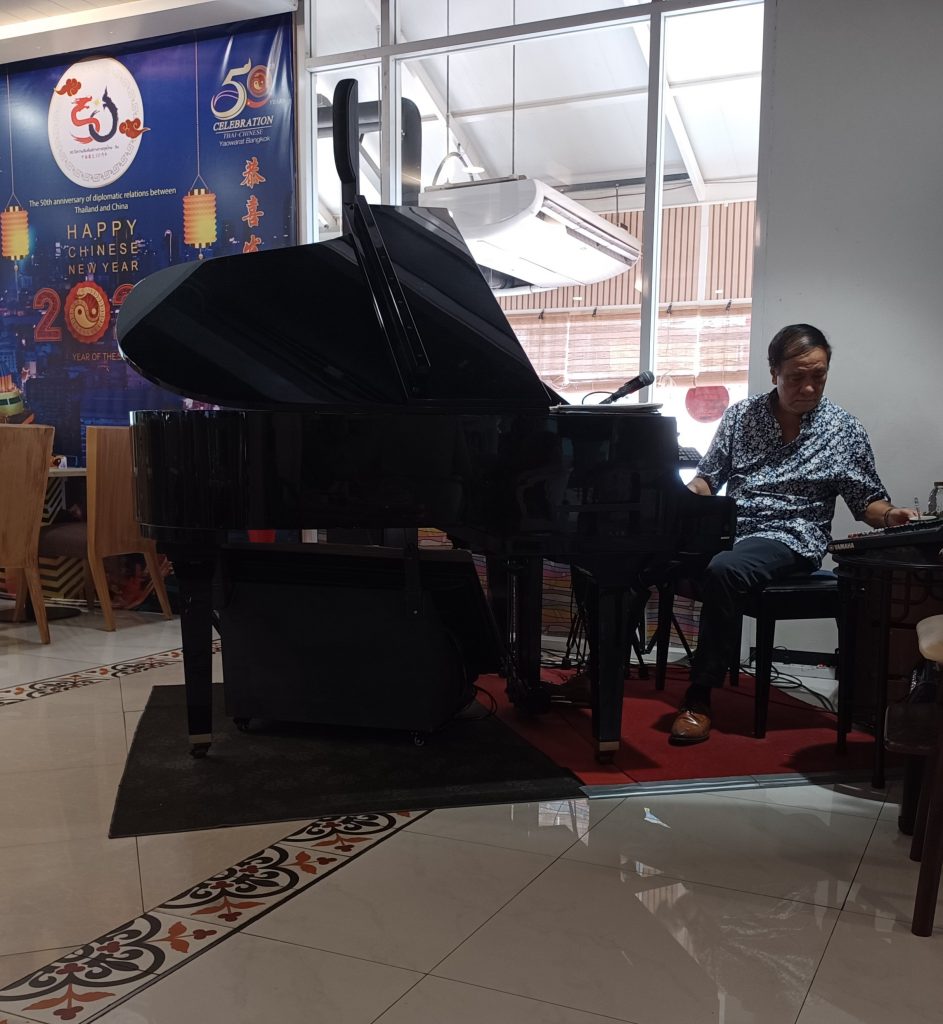
How to kill a bit of time before check in. Had passed a barber’s shop and peered through the window earlier. Unisex establishment it seems. I need a haircut. Take the plunge and go in. Hairdresser speaks not a word of English. Why should she? I speak not a word of Thai. Anyway, she cuts my hair, then washes it, giving scalp a thorough scrub, before blow drying. Bit shorter cut than my usual and perhaps more well-groomed than the wilder look I prefer but better than before. Quite satisfied. Can check in to the hotel now. Afterwards while away the remainder of the time exploring.
The wat near the hotel in Chinatown summons me. Its name is Wat Traimit Witthayaram and it houses a solid gold Buddha statue, worth millions, which is located on the top floor. The temple complex provides a residence for monks, whom I see round and about dressed in their saffron robes. A fascinating complex to roam around.
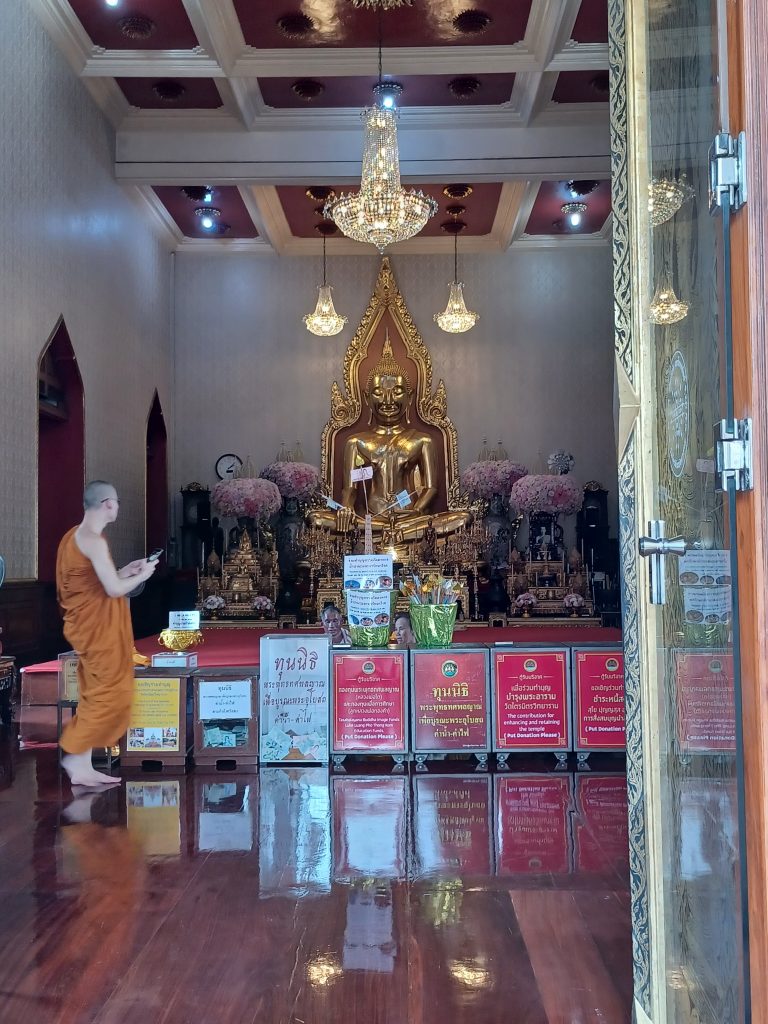
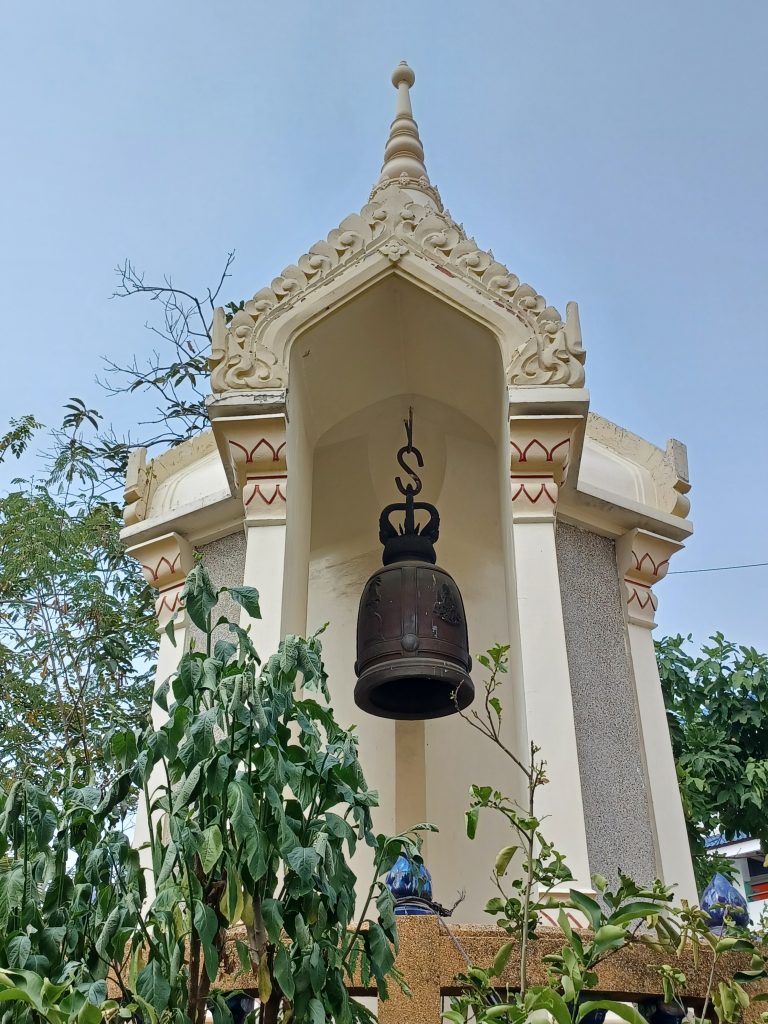
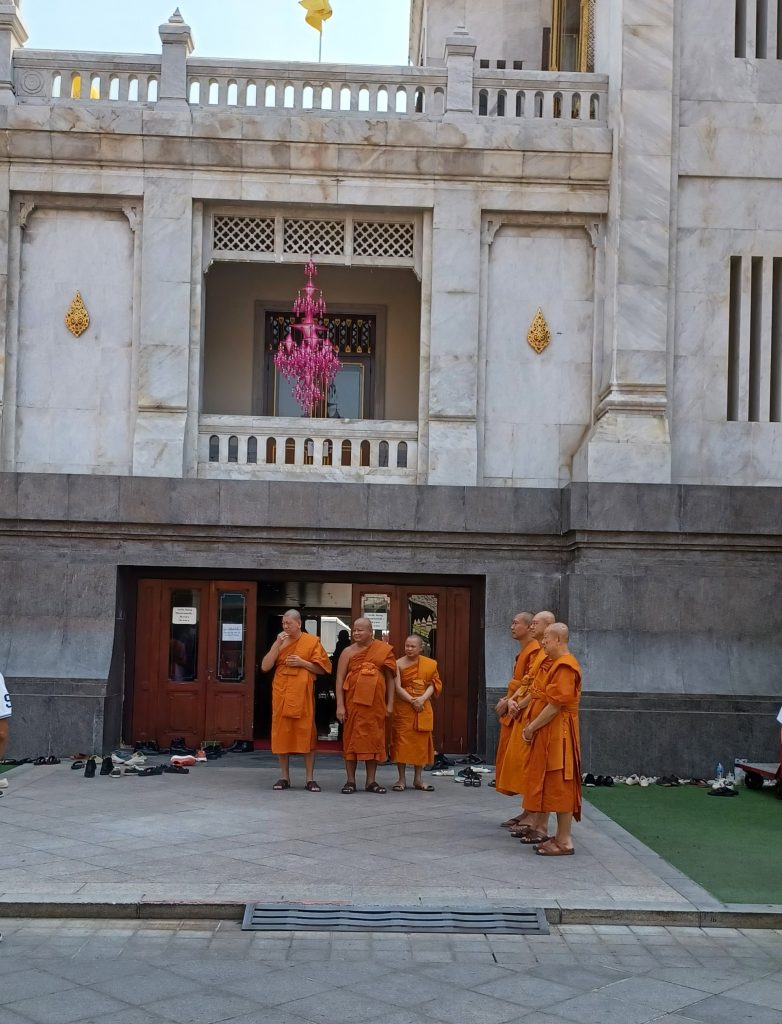
Boat ride on the khlongs
Today I am due to join a tour of Bangkok. First up is a boat trip on one of the Chao Praya’s khlongs (canals). These khlongs were once a vital part of Bangkok’s transportation system. A ten minute stroll from the hotel and we arrive at the river front on Ratchawong pier. And we board a nice looking slim long boat. The skipper does not tie the boat up, I notice, merely uses the engine to keep the red wooden bow against the pontoon while we all hop on. Well, some of us do. Some arms reach out to assist the less able. Shove on compulsory bulky lifejackets and off we go. The boatman applies the throttle, speeding along at several knots, producing an impressive wake either side.
A lady guide with high pitched voice with sing song tones uses a microphone, which is less than efficient, to give the low down on the sites of interest. Although the volume is loud the bunch in the boat receive a distorted sound, not conducive to understanding the commentary. The fact that the speaker’s sentence intonation always rises at the end can become a distraction, especially when the last word of each sentence is ‘yes’. I switch off. I enjoy being low down on the water though and watching the scenery flit by. Breeze blows cobwebs away and fingers trail in the water.
We pass now familiar landmarks on the river, then turn to port down a khlong. Several fine temples hove into view and the king’s boat shed where the royal barges are kept. Wooden khlongside buildings, more egrets on lilies, frangipani trees and palms.
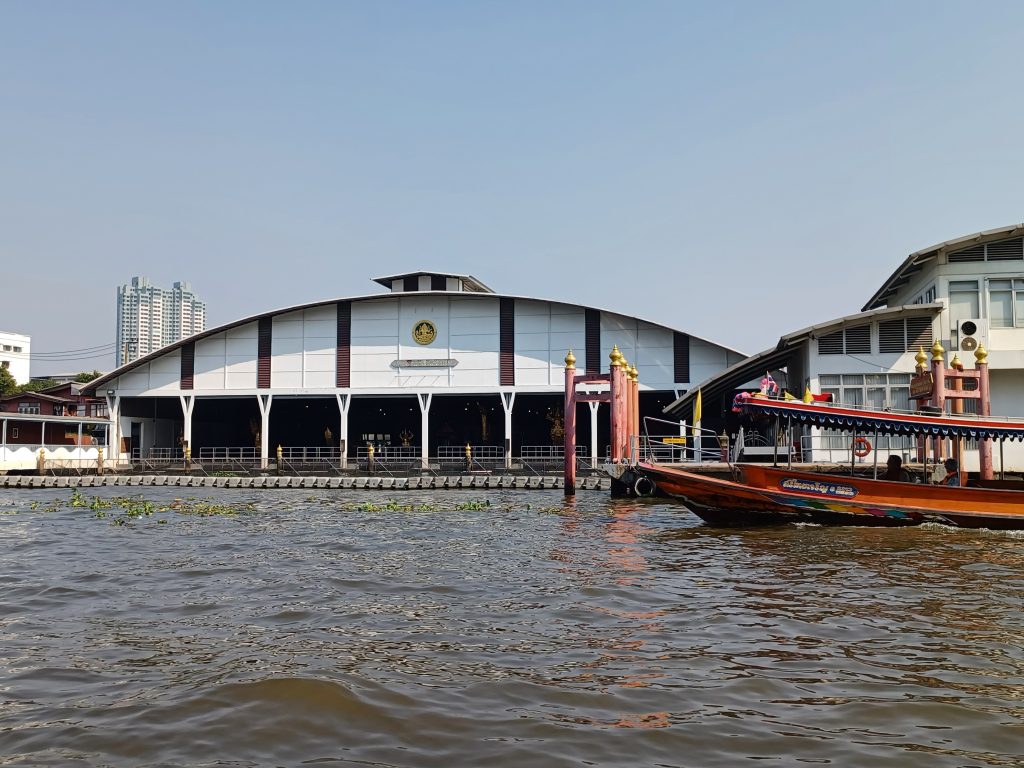
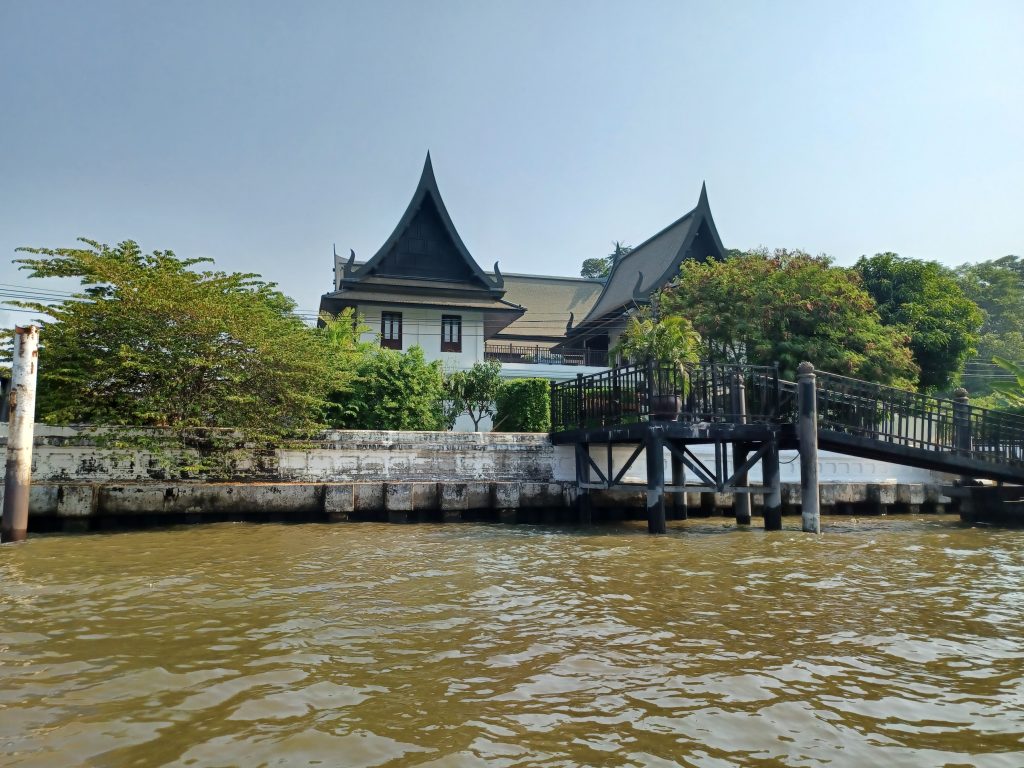
Wat Pho
Boat trip over, we disembark and are led to Wat Pho, the Temple of the Reclining Buddha. This is the grandest temple complex in Bangkok, situated on the east bank of the Chao Praya river. Within the Assembly Hall (Phra Viharn), which was founded by King Rama I as a royal monastery, resides the main attraction of the temple, a gigantic reclining Buddha, 46 metres long. The monastery was restored between 1831 and 1848 by King Rama III, the reclining Buddha being built during this restoration. It is made of bricks and covered with lacquer and gold leaf. It lies on its right side as the right side is supposed to be ‘the most powerful sleeping position of the king of lion,’ according to a notice. The Buddha is about to enter Nirvana.
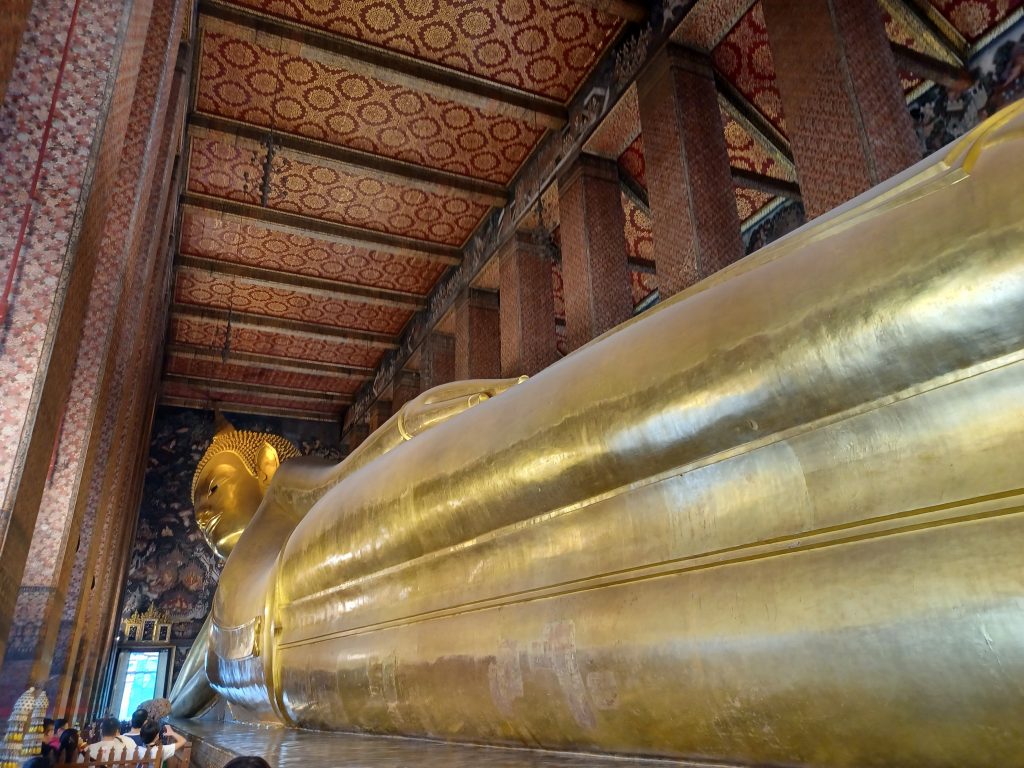
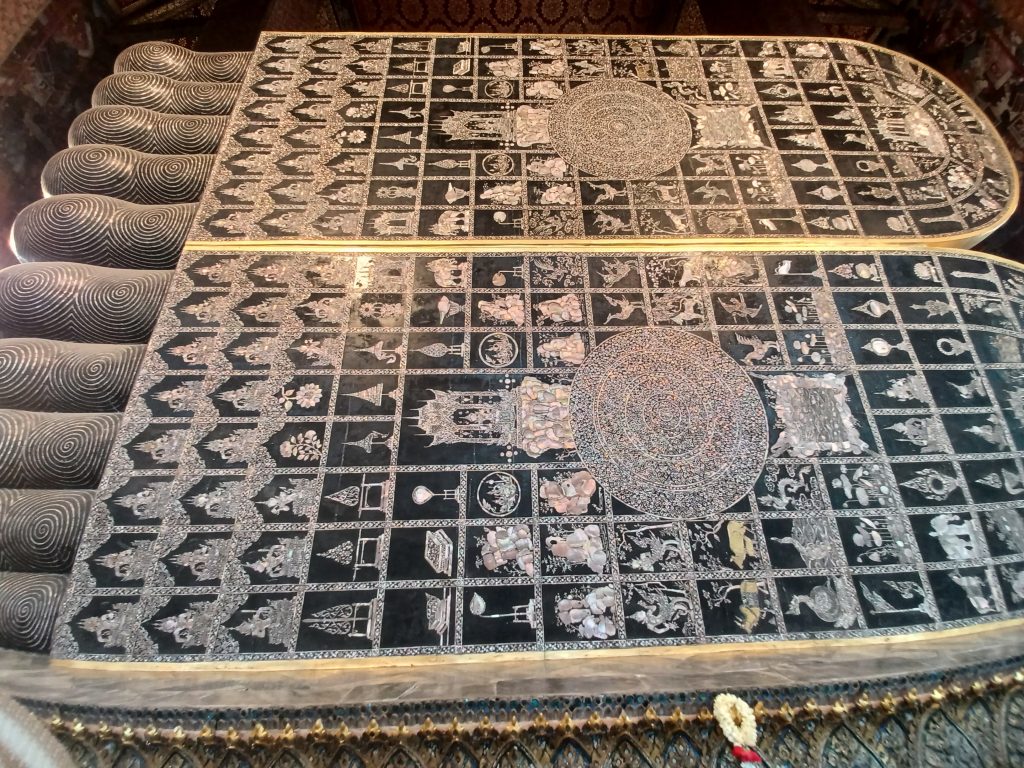
Many cameras photograph the Buddha, from its serene face along the length of its recumbent body to its massive feet. The soles of both feet are covered in mother-of-pearl shell and depict the chakra wheel and ‘108 auspicious panels with exceptional craftsmanship’. The head rests on a stone pillow. The hair appears to consist of hundreds of mini stupas and on the top of the head is a protuberance from which a flame emanates. This attachment to the head proves that it is indeed a Buddha, we are informed. Exotic murals lining the hall depict stories of Buddha’s life.
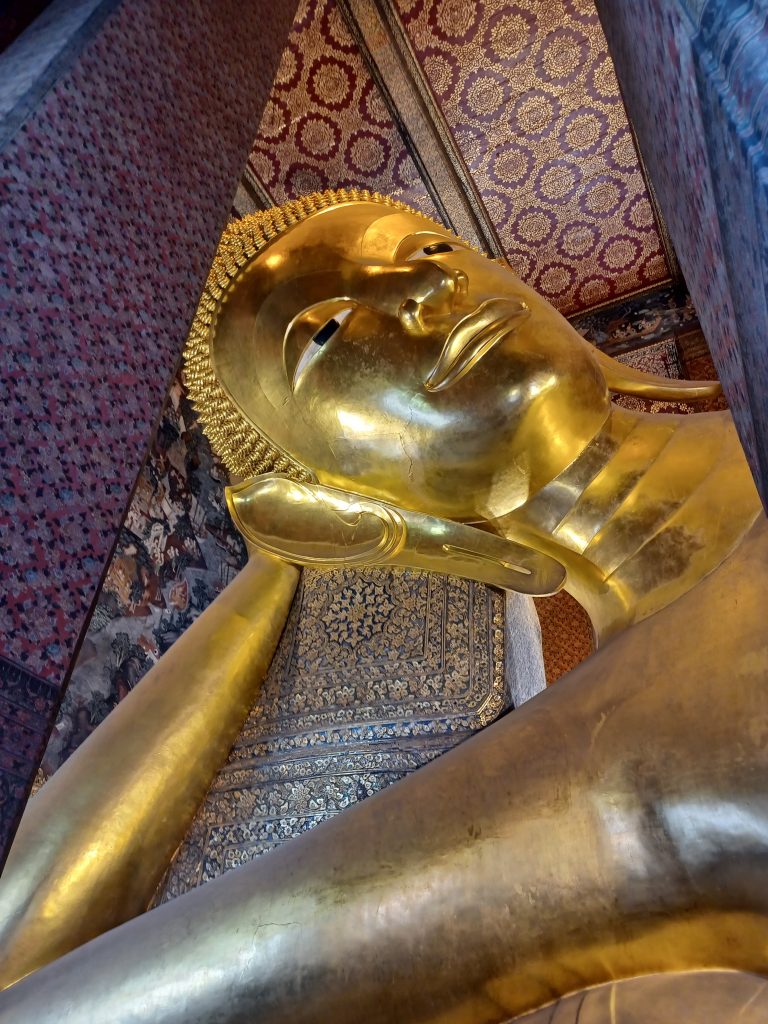
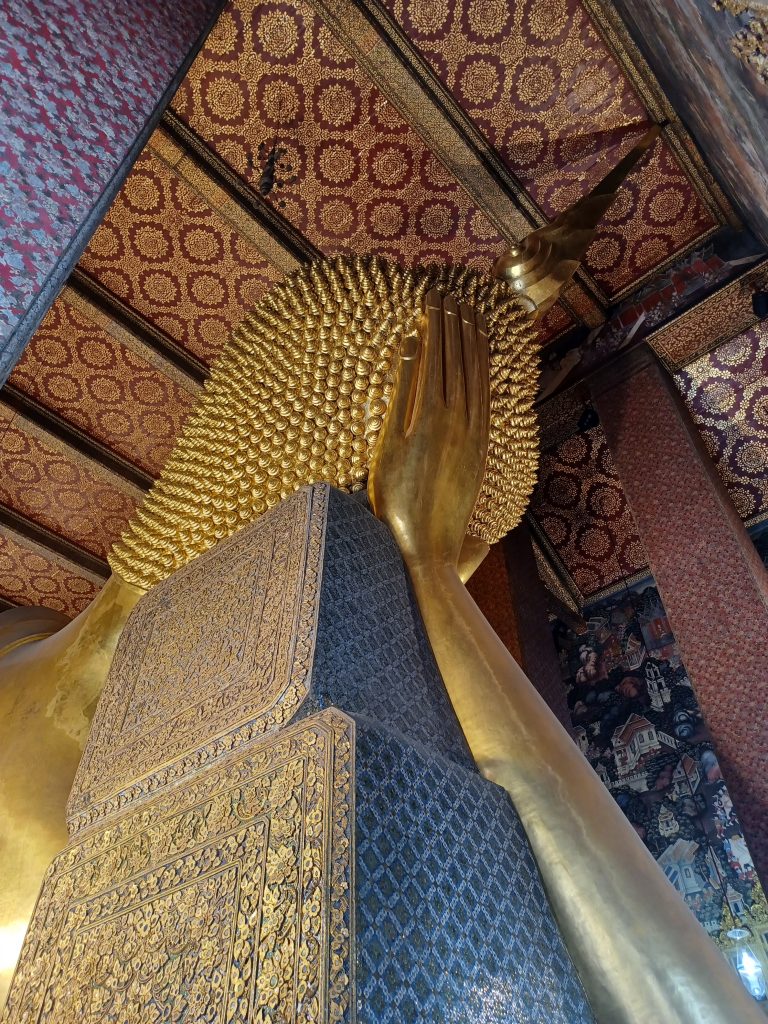
Leave the Buddha to recline in peace and exit to explore the temple precincts with its pavilions, elaborate staircases, stone figures with Chinese or European faces, and its stupas. Of the many stupas, the four largest ones contain the ashes of the Chakri kings. The guide says there are ashes inside all of them but that there is not enough room for everyone who wishes for their ashes to be kept here anymore. Her family though, she says, has its own stupa in which to deposit their ashes.
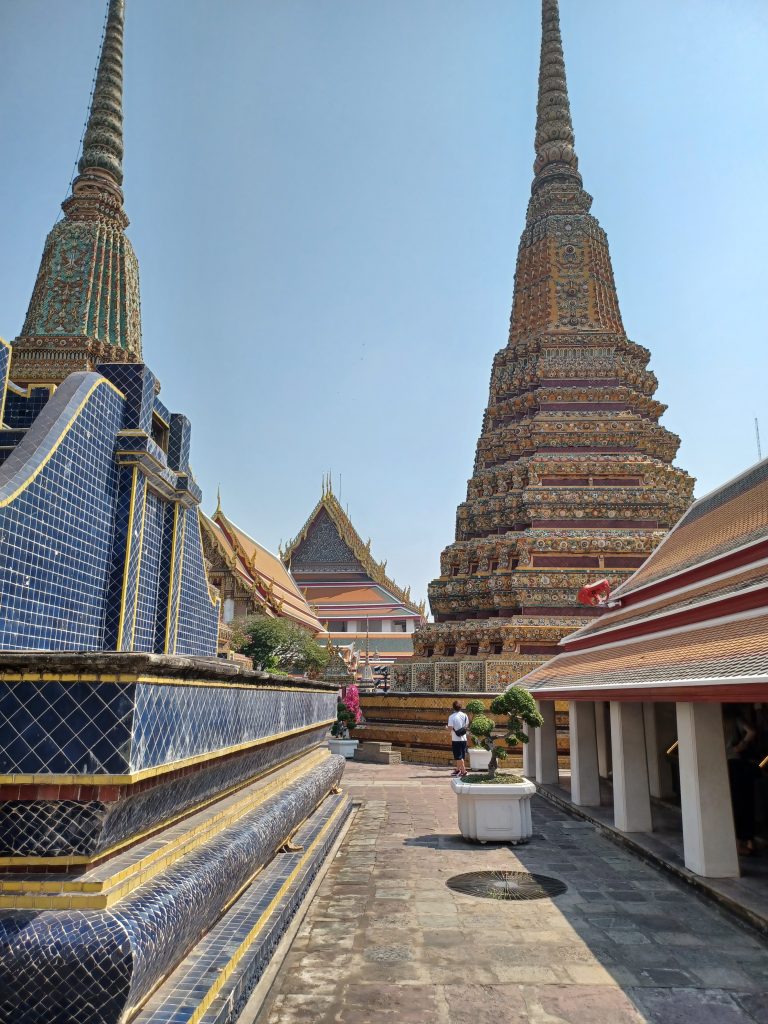
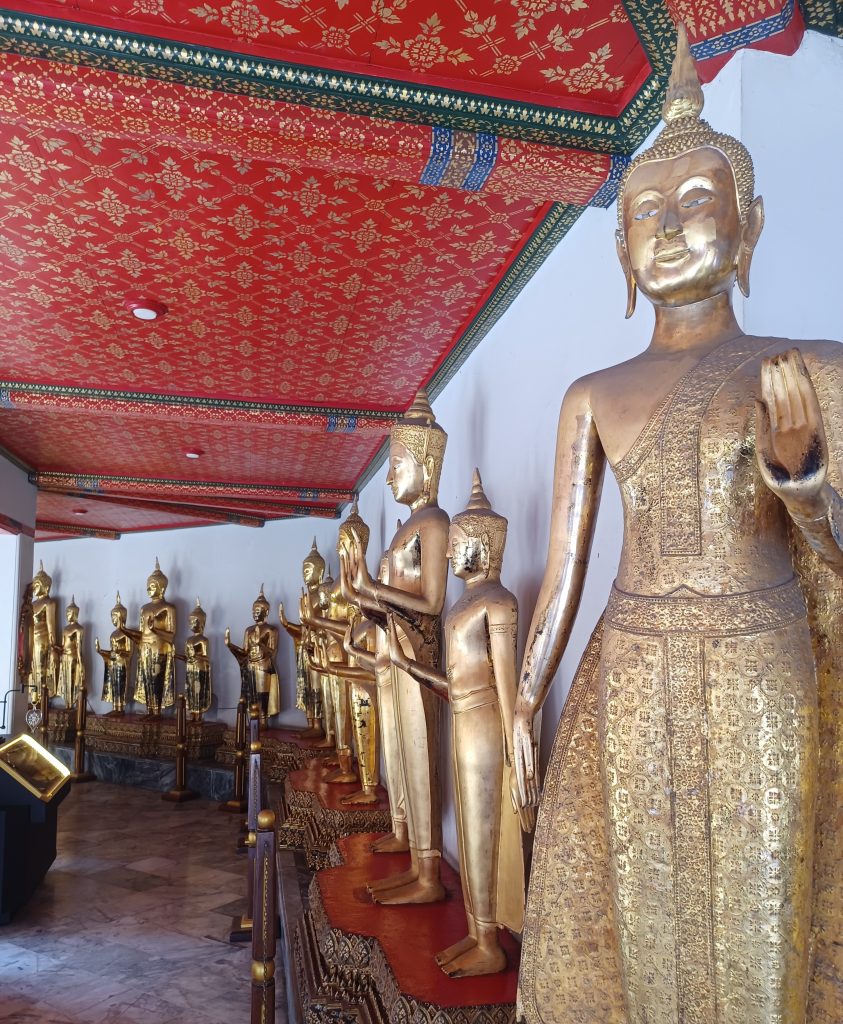
There are images of Buddha everywhere. There are over a thousand of them, mostly made of bronze and covered with gold and black lacquer, within the complex. They were apparently brought here from various ancient cities around Thailand. About 400 of them, standing or sitting cross-legged, are located in the inner and outer Cloisters. The Cloisters protect the important Ordination Hall in which is the principal Buddha image.
Exit Wat Pho now and proceed along hot roads parallel to the river towards the Grand Palace. Am wilting somewhat. No shade. Pass a stall selling crocodile heads and other delicacies. Grilled crocodile meat on sticks cost 120 bhat and a fried crocodile tail only 200 bhat. This part of the reptile is clearly a better cut. Resist the temptation.
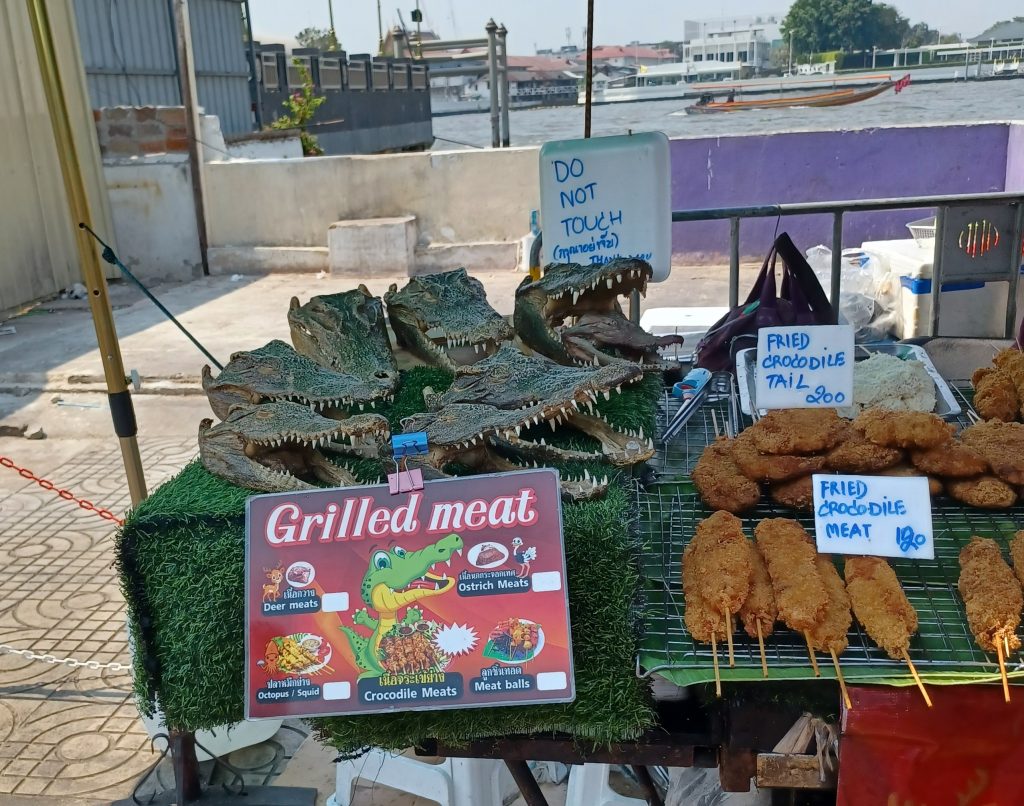
Grand Palace
The Grand Palace, once the official residence of the Kings of Siam is now the official ceremonial residence of Thai kings. More majestic architecture greets us: awe-inspiring stupas, pavilions, courtyards, and mythical figures guarding entrances. Talk about opulence and grandeur. Begun in 1782 by King Rama I and restored and added to by successive kings of Thailand. We enter between two tall stupas into a pavilion.
It is hot. Sensible folk are sporting parasols or umbrellas. We enter the Cloisters, which protect and enclose the temple buildings, I understand, and peruse the walls. They are covered with murals from top to bottom, which portray scenes from the Ramakien, a Thai version of the Ramayana, the Indian epic, featuring elephants and gods, soldiers, demons, temples and more.
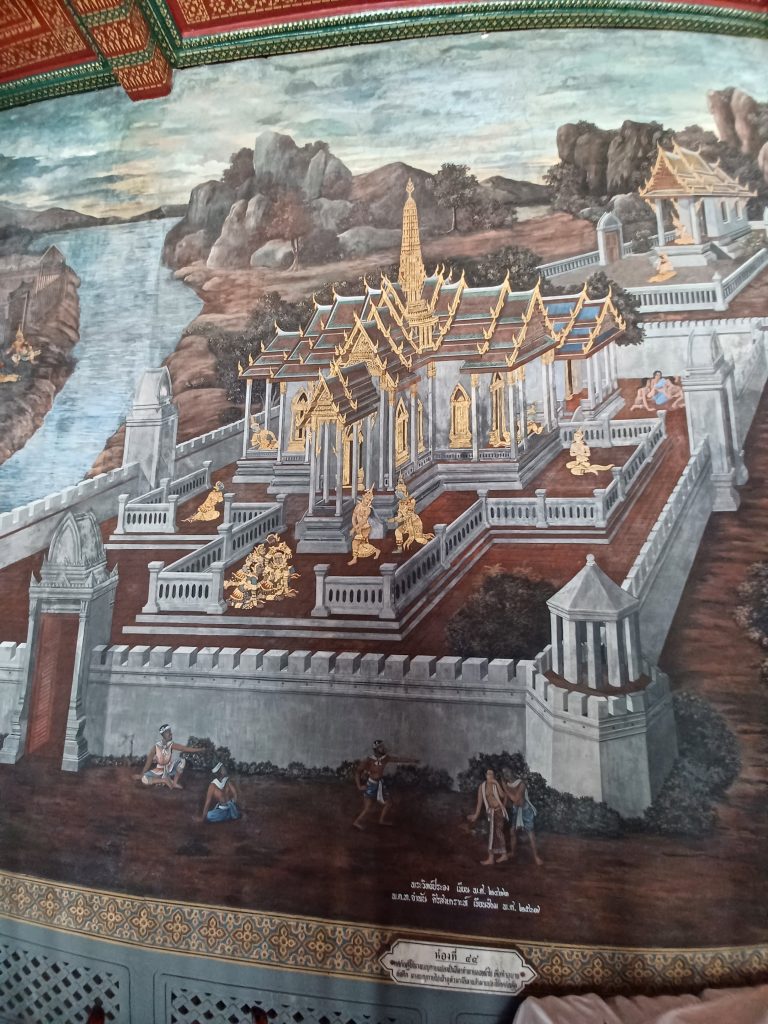
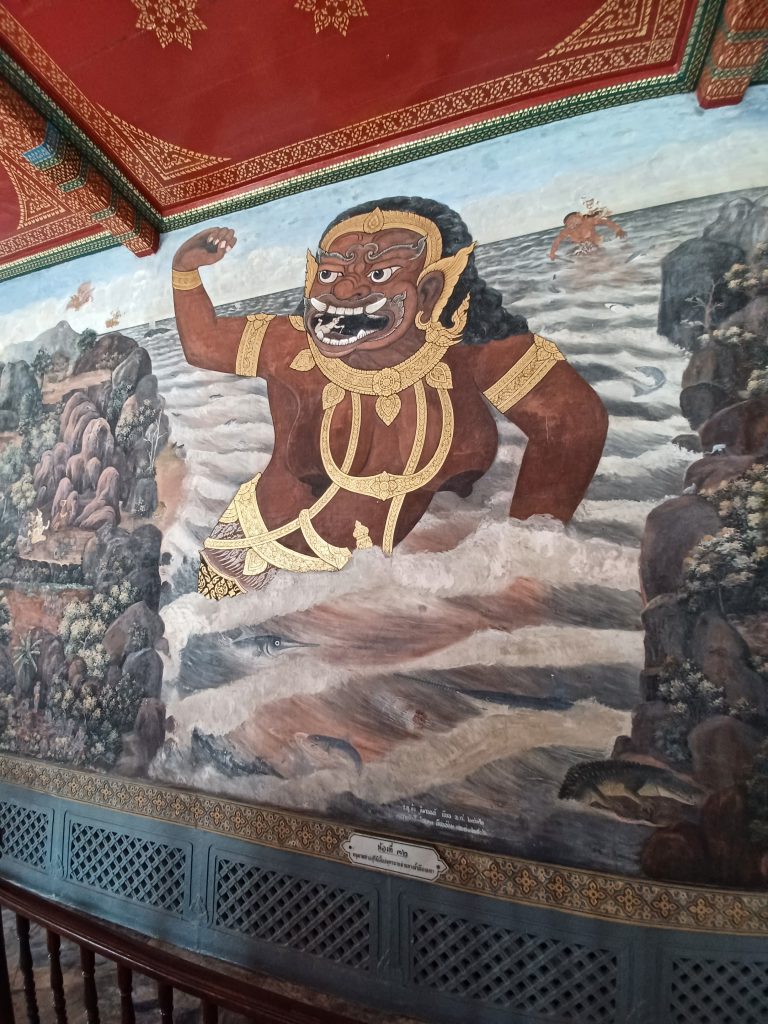
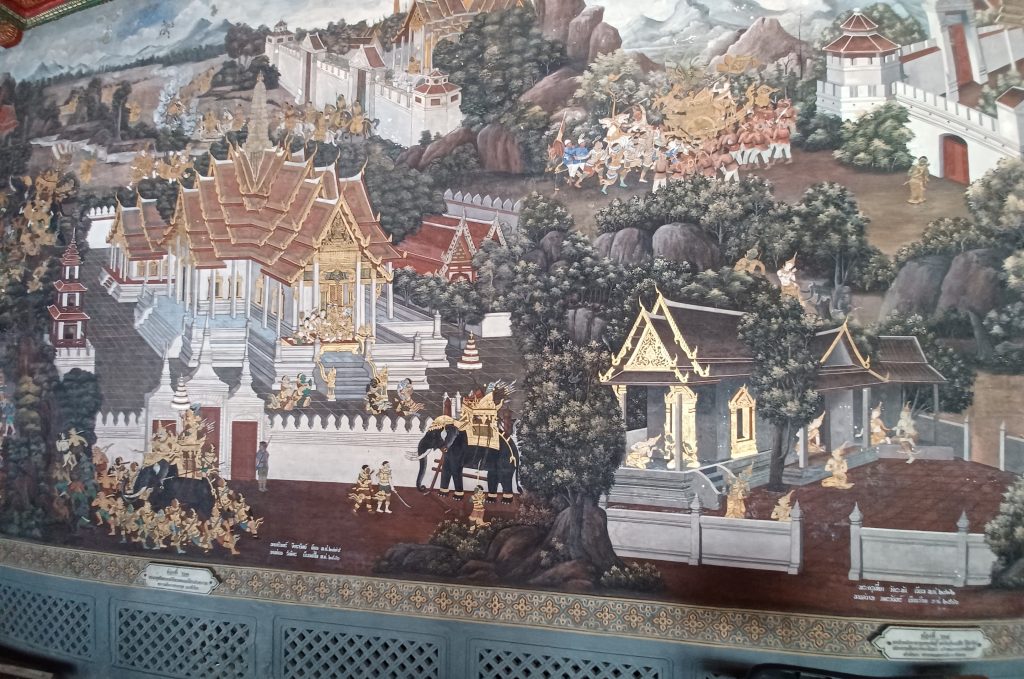
Temple of the Emerald Buddha (Wat Phra Kaew)
We now approach the entrance to the Temple of the Emerald Buddha, the most sacred Buddhist Temple in Thailand. A pair of Demonic Guardians, as portrayed in the Ramakien epic, protect the temple entrance. Remove shoes and place on shoe racks stuffed with foot-ware before entering to view the legendary Buddha. It is made of a single piece of jade, perhaps jasper. Nobody seems quite sure except that it isn’t emerald. Not allowed to take photos here.
The Buddha is quite small actually, just over two feet high. It is dressed in gold. Its raiment is changed by the King, the only person permitted to touch it, three times per year according to the season: summer, rainy and winter. It was moved from its former residence in Wat Arun and placed in the Grand Palace in 1785.
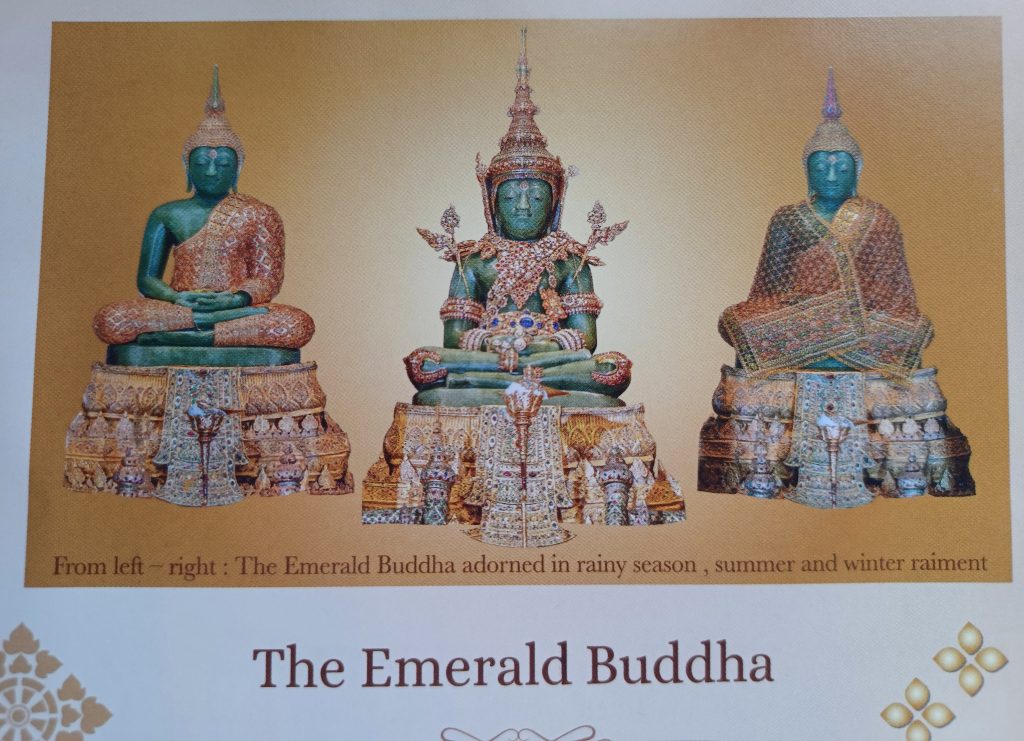
Opposite the entrance, casually posing in front of the Temple of the Emerald Buddha, is a ‘Bronze Hermit’. King Rama III apparently much appreciated the skills of hermits who were knowledgeable in herbal medicine, among other things, and he wished to commemorate them. Some people make offerings to said hermit or touch its head for good luck.
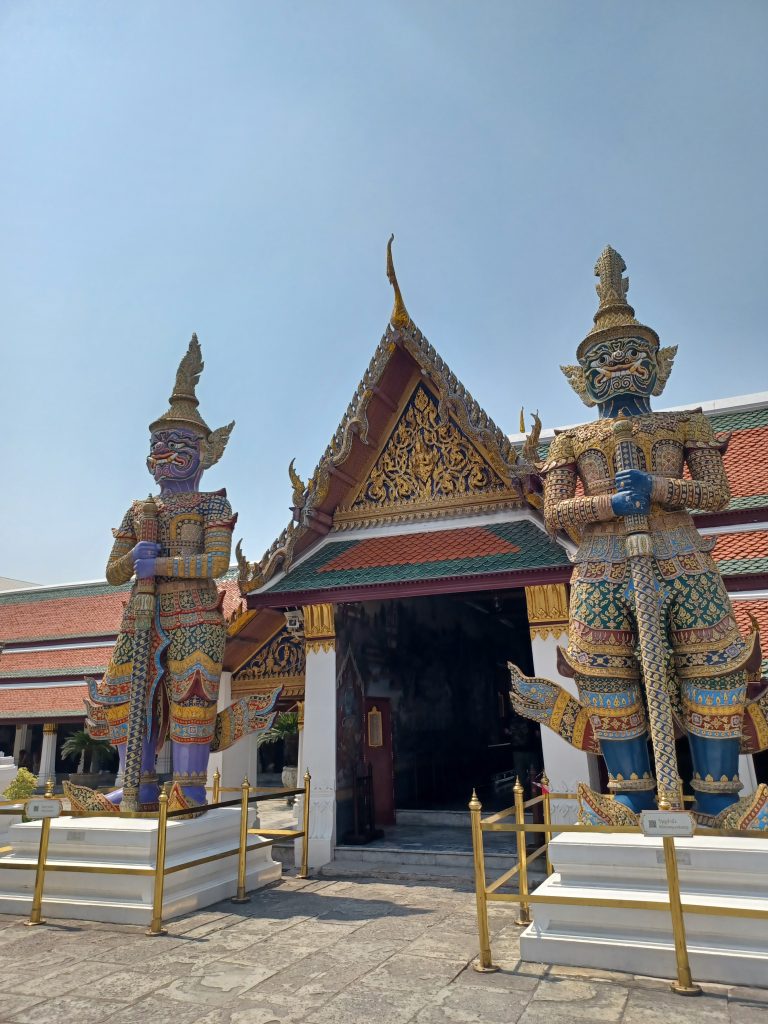
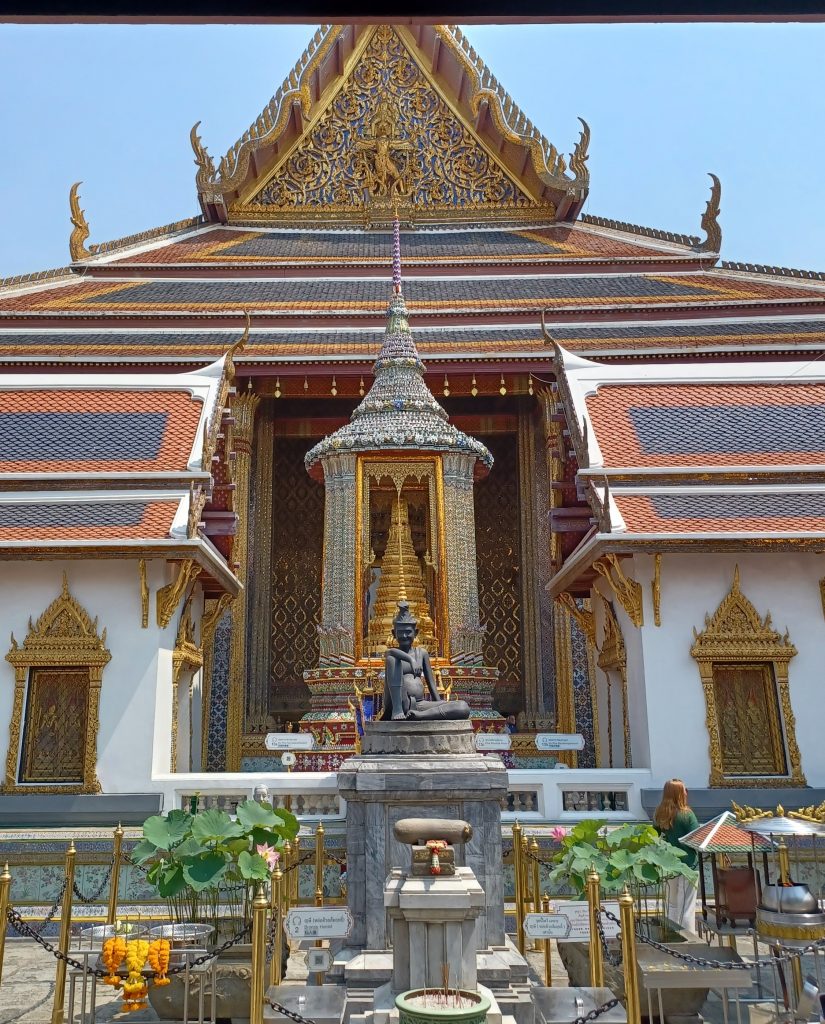
Walk about and marvel at the entrance to the Royal Pantheon, flanked each side by gilded chedis (stupas). These have mythical warrior figures around the base, as at Wat Arun, and are stunning. Built by Rama I, apparently one chedi is dedicated to his mother, the other to his father. The Royal Pantheon was built initially to house the Emerald Buddha but considered too small.
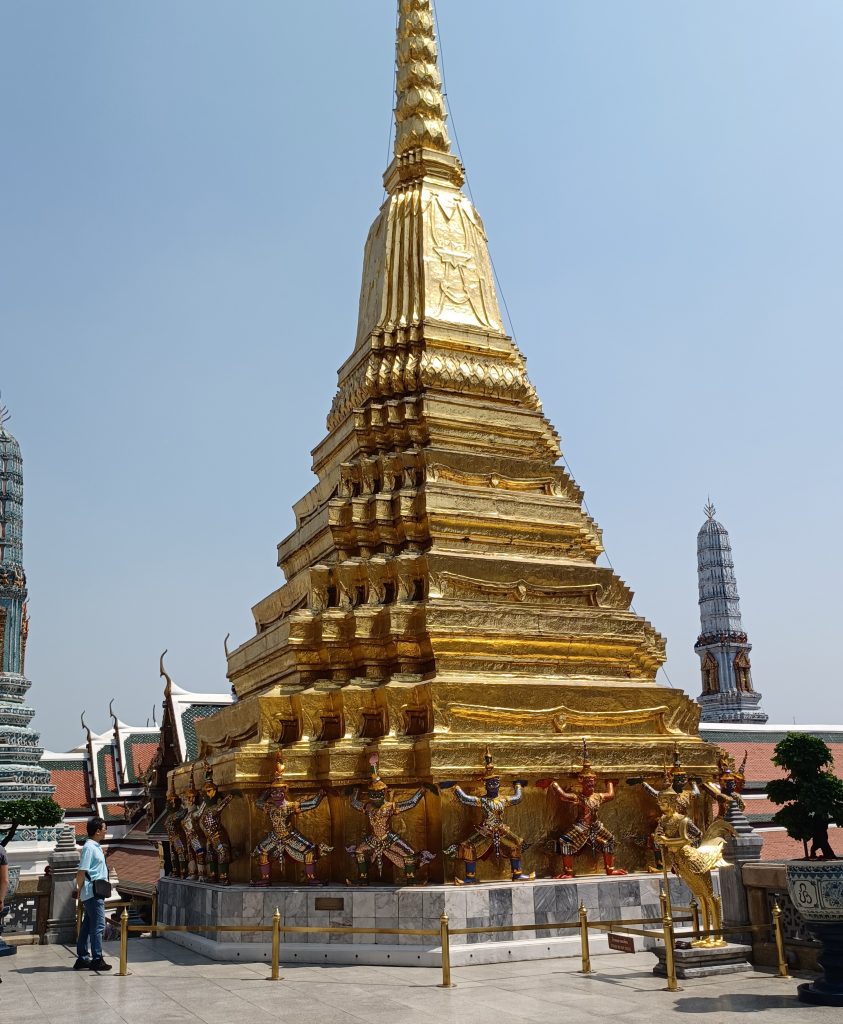
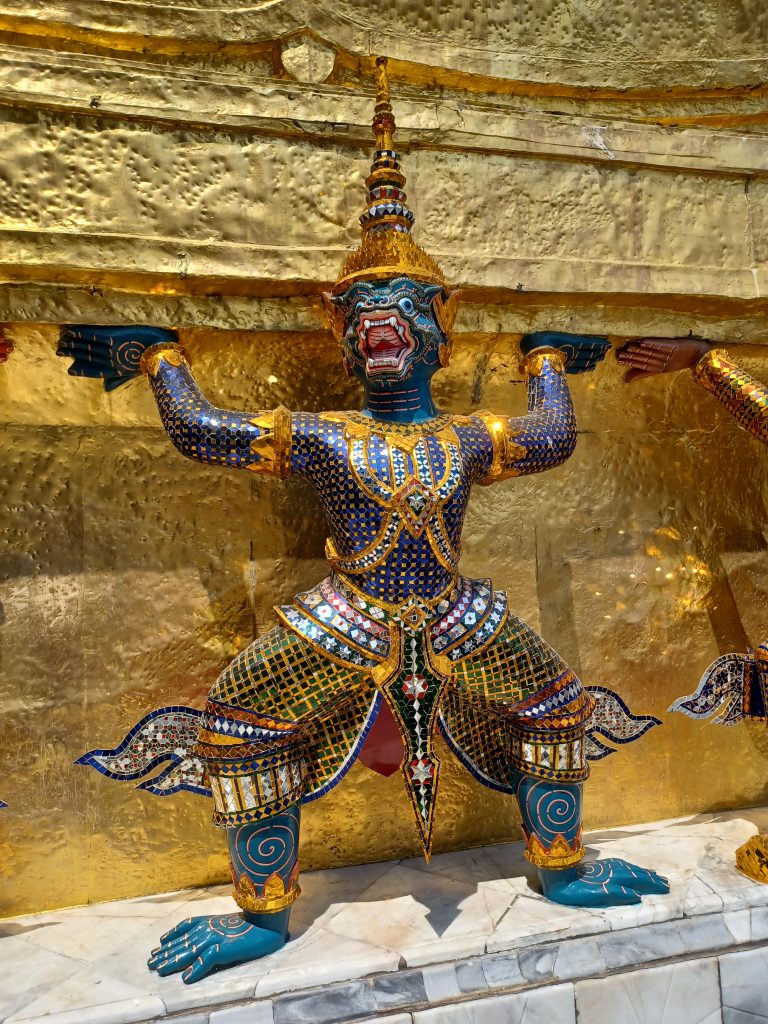
A stone statue depicting a bearded European with hat and pipe, jacket and trousers seems out of place here. Apparently many stone statues were found buried behind the palace’s east walls in 2021, their provenance being Guangdong province in China. This one is standing outside the Royal Pantheon. Elsewhere are half woman half lion mythical figures, and mythical birds. And a massive bell shaped chedi made of brick and covered with gold mosaic tiles.
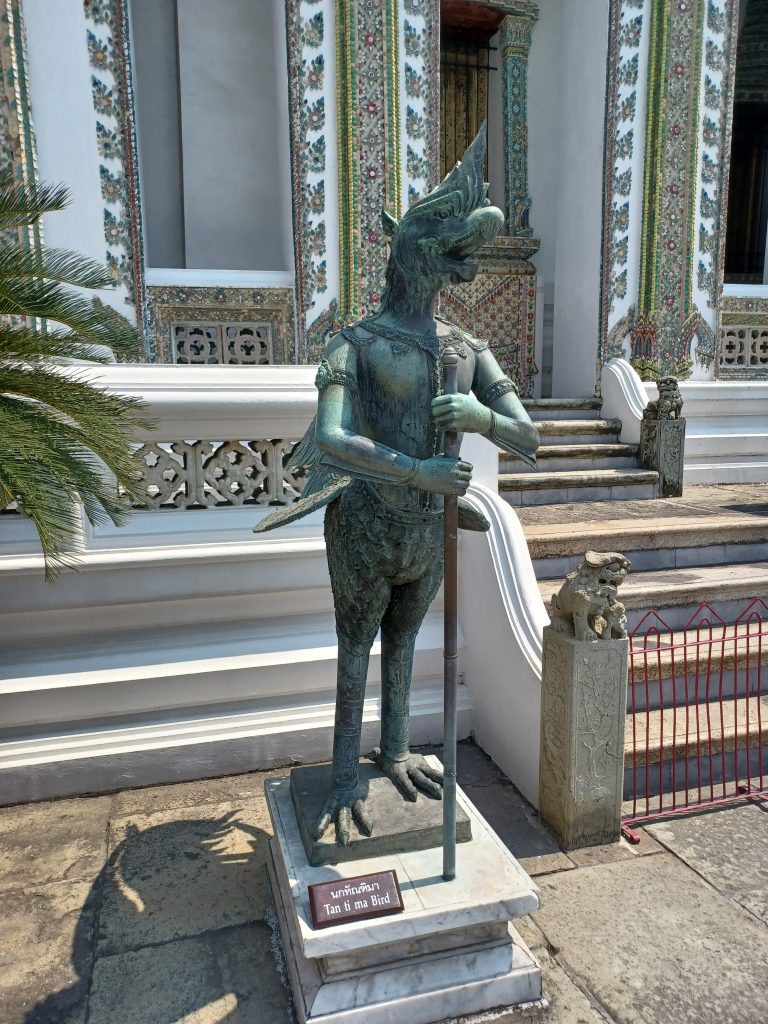
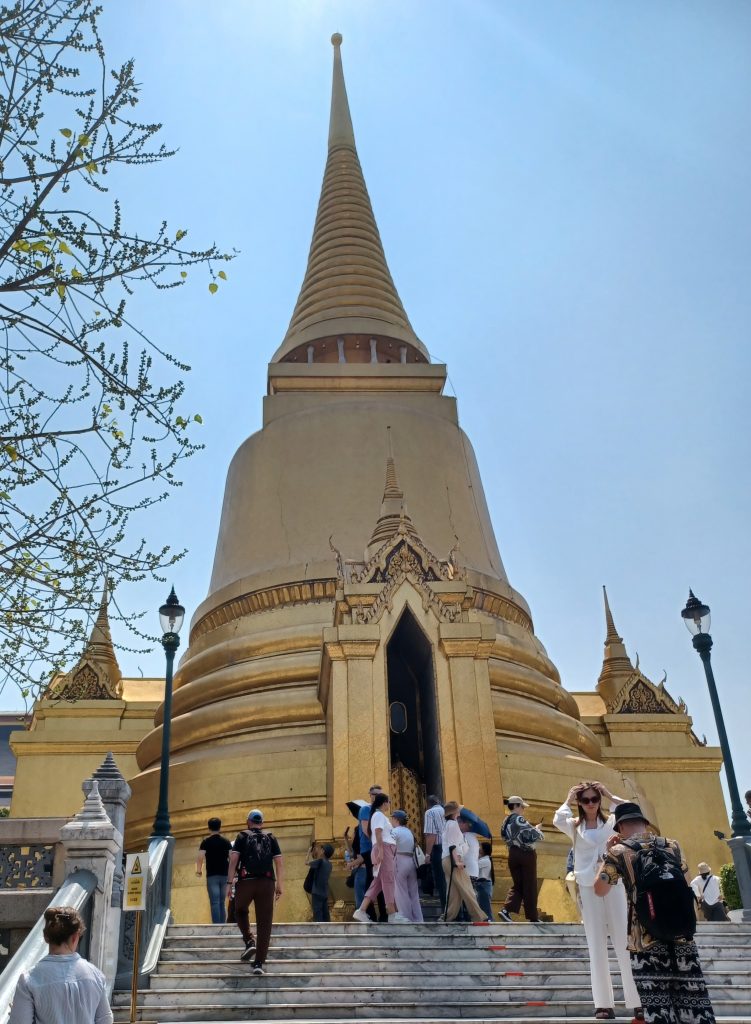
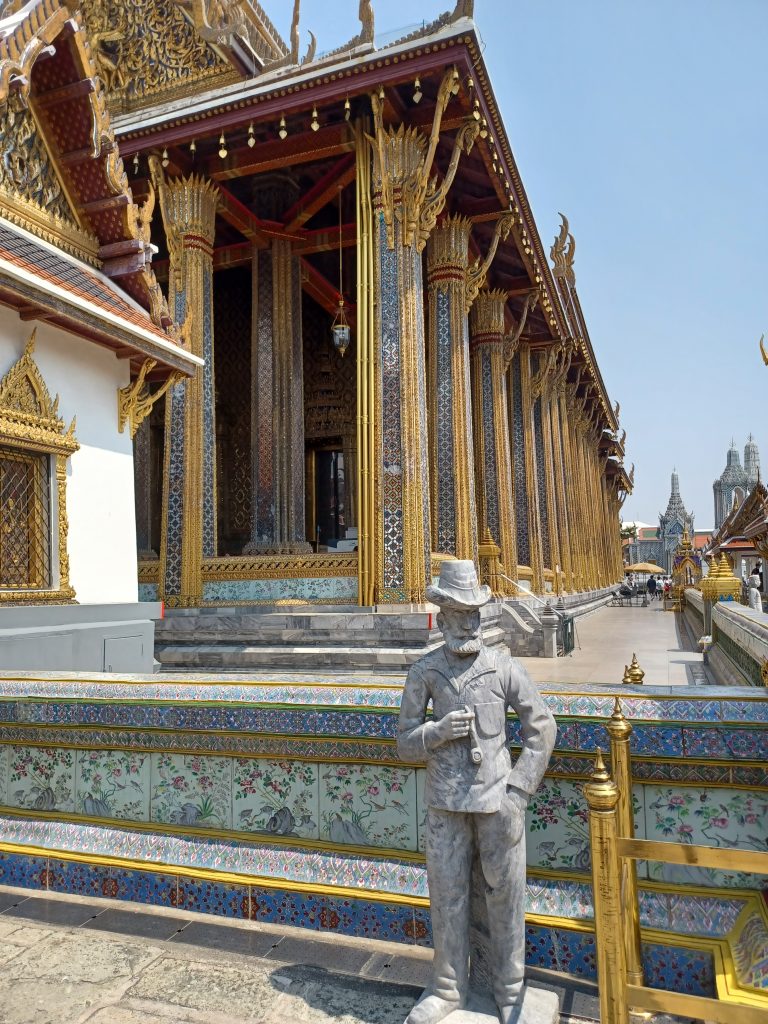
We head out and pass the lavish Throne Hall. A less than usual mix of European architecture at the bottom and Thai on top. Built by Rama V in the late 19th century. Four white elephant statues stand at the entrance, trim lawn in front and topiary resembling bunches of lollipops.
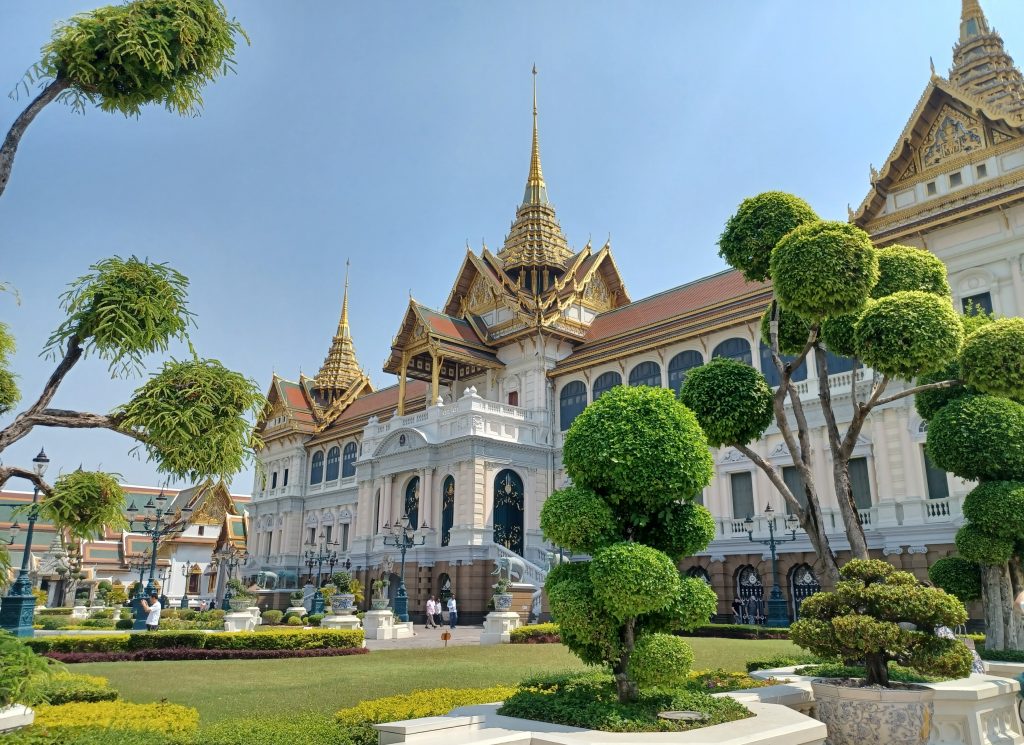
The Throne Hall is used for ceremonial occasions such as receiving ambassadors and state banquets. The Coronation of King Rama X took place here in 2019.
The grandeur of the Grand Palace leaves me feeling a bit stupefied. Eyes now need to rest in a darkened room. And it is very very hot. Refreshment required first though. Find a fine restaurant for lunch close by the Palace exit. Its air conditioning unit blasts at us as we pass through the door. Sublime. I try ‘Lassi’ – a yoghurt based drink with mango and dragon fruit – to accompany curry and spring rolls. Hits the spot. Take a tuk tuk back to the hotel to rest up.
My time in Bangkok is now over. Fascinating place. A weird mix of mundane modernity and glittering magnificence. I like it.

Leave a Reply